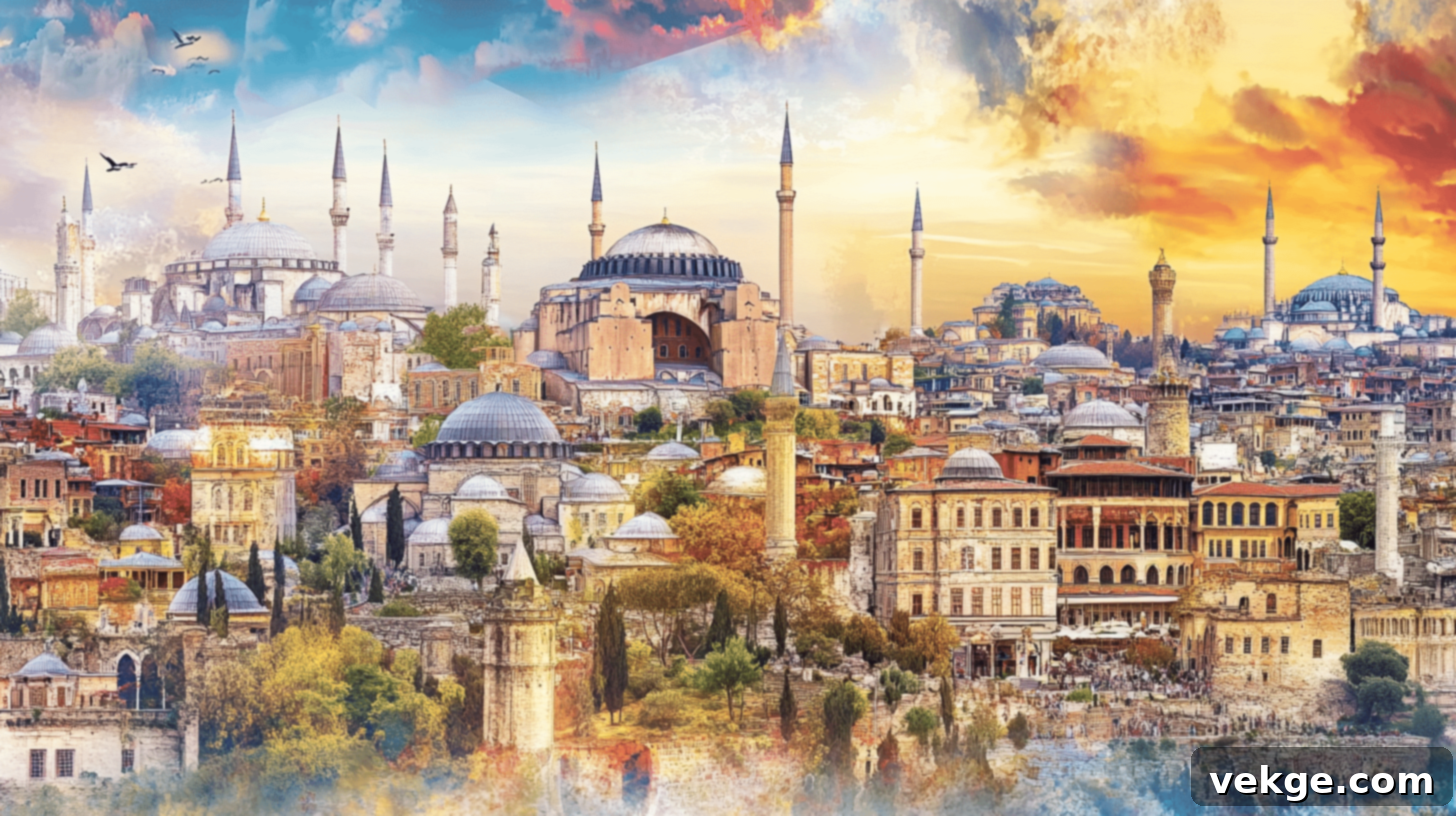Explore Turkey’s Magnificent Landmarks: An Unforgettable Journey Through History and Culture
Welcome to the ultimate guide to Turkey’s magnificent landmarks! This captivating land, where the continents of Europe and Asia converge, is a living testament to thousands of years of human history, rich civilizations, and unparalleled natural beauty. From the majestic mosques and opulent palaces of Istanbul to the remarkably preserved ancient Greek and Roman ruins scattered along its stunning coastlines, Turkey truly offers an extraordinary experience for every kind of traveler.
Whether you are a seasoned adventurer, a history enthusiast, a culture seeker, or simply someone yearning for a truly unique and enriching travel experience, Turkey’s diverse landscape and heritage promise an unforgettable journey. In this comprehensive guide, we illuminate the must-visit sites across the country, providing insightful historical context and essential practical information to help you meticulously plan your visit. Prepare to be enchanted by architectural wonders, mesmerized by natural spectacles, and deeply moved by the cultural tapestries that await you in this incredible nation.
Turkey’s Enduring Legacy: A Crossroads of Civilizations
For millennia, the Anatolian peninsula, modern-day Turkey, has served as a pivotal meeting point of cultures, empires, and spiritual traditions. This land has witnessed the rise and fall of countless civilizations, each leaving an indelible mark on its landscape, architecture, and cultural identity. From the earliest human settlements to powerful ancient empires and the grandest medieval dynasties, Turkey’s history is a vibrant mosaic.
The mighty Hittites, arriving around 1600 BCE, brought advanced iron-working skills and established one of the ancient world’s most formidable empires. Centuries later, the Romans sculpted grand cities across Anatolia, adorned with magnificent theaters, intricate temples, and sophisticated infrastructure, remnants of which stand proudly today. The Byzantines, centered in Constantinople (modern Istanbul), bequeathed a legacy of breathtaking churches, stunning mosaics, and a rich artistic tradition that blended classical and early Christian influences.
Following them, the formidable Ottoman Empire reigned for over six centuries, dramatically transforming the landscape with its iconic mosques, palatial complexes, and bustling bazaars that fused Islamic and local Anatolian artistry. This continuous layering of cultures has resulted in a staggering array of historical and architectural treasures. Today, Turkey proudly boasts 19 UNESCO World Heritage Sites, a testament to its profound global significance. These range from the legendary battlegrounds of ancient Troy and the otherworldly rock formations of Cappadocia to the intricate ruins of Hierapolis-Pamukkale and the ancient city of Ephesus. These places collectively narrate the fascinating story of the many different peoples who have called this extraordinary land home over countless generations.
Essential Turkish Landmarks: Your Must-Visit List
Embark on a captivating tour of Turkey’s most iconic destinations. Each site offers a unique window into the country’s diverse past and present, promising breathtaking sights and profound cultural insights.
1. Hagia Sophia (Ayasofya) – Istanbul
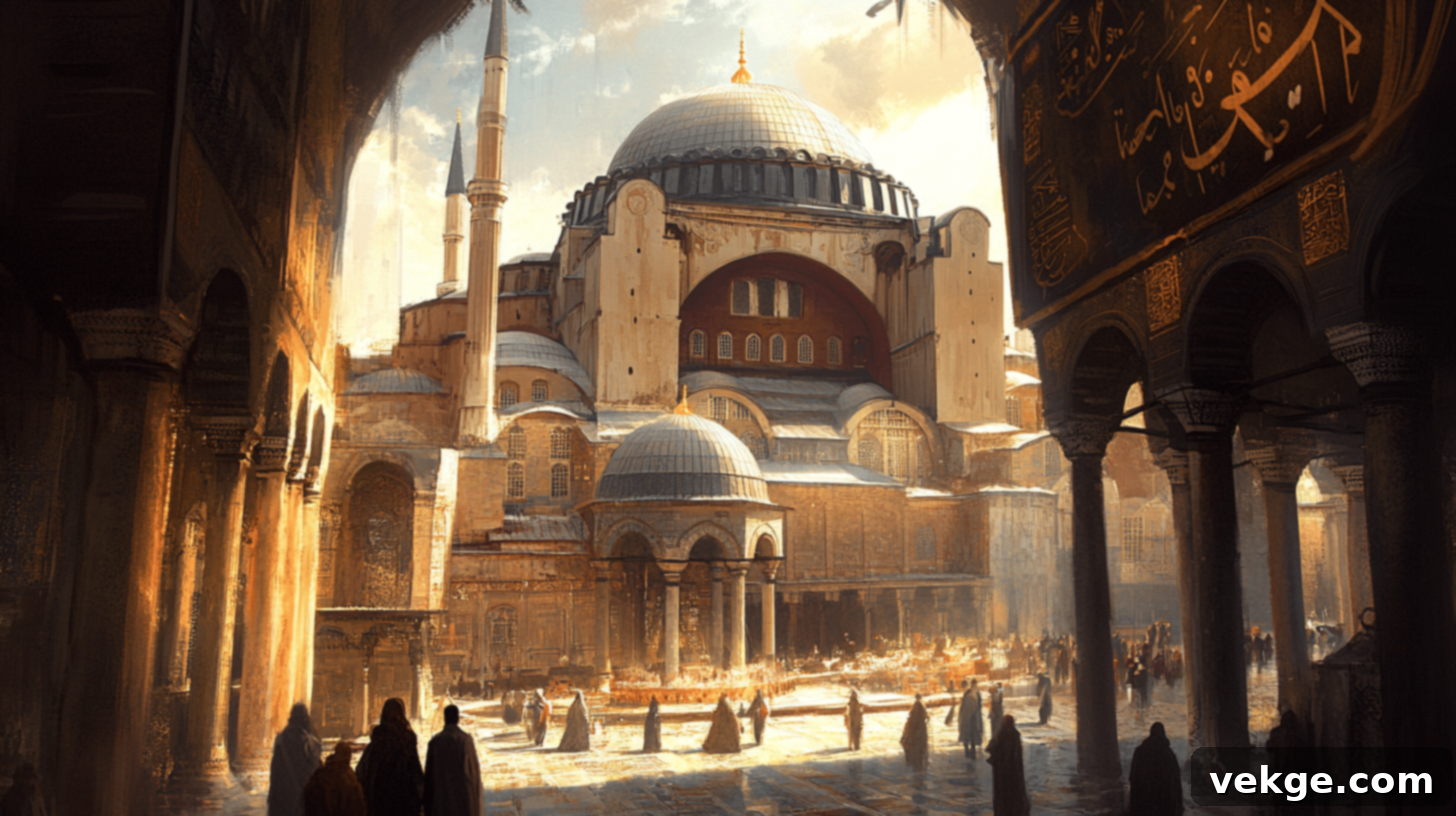
A true architectural marvel, Hagia Sophia stands as an enduring symbol of Istanbul’s rich history. Originally built in 537 CE as a grand Byzantine cathedral, it later served as an imperial mosque, then a museum, and has recently reverted to a mosque. Its colossal dome, a triumph of early engineering, soars above an interior adorned with layers of history. Here, ancient Christian mosaics depicting saints and emperors coexist harmoniously with intricate Islamic calligraphy and mihrabs, showcasing Turkey’s complex and multicultural heritage. The sheer scale and intricate details of Hagia Sophia leave visitors in awe, reflecting centuries of spiritual and political transformation.
- Best Time to Visit: Late spring (April-May) and early autumn (September-October) offer mild weather and fewer crowds, enhancing the experience.
- Guided Tours: Highly recommended historical walking tours delve deep into the building’s multifaceted history and architectural significance. Mornings are generally less crowded.
- Entry Fees and Hours: Entry is free as it is a working mosque. However, tourists are generally not permitted during the five daily prayer times. Opening hours for visitors are typically 9 am-7 pm daily, except during major religious holidays.
2. Topkapi Palace – Istanbul
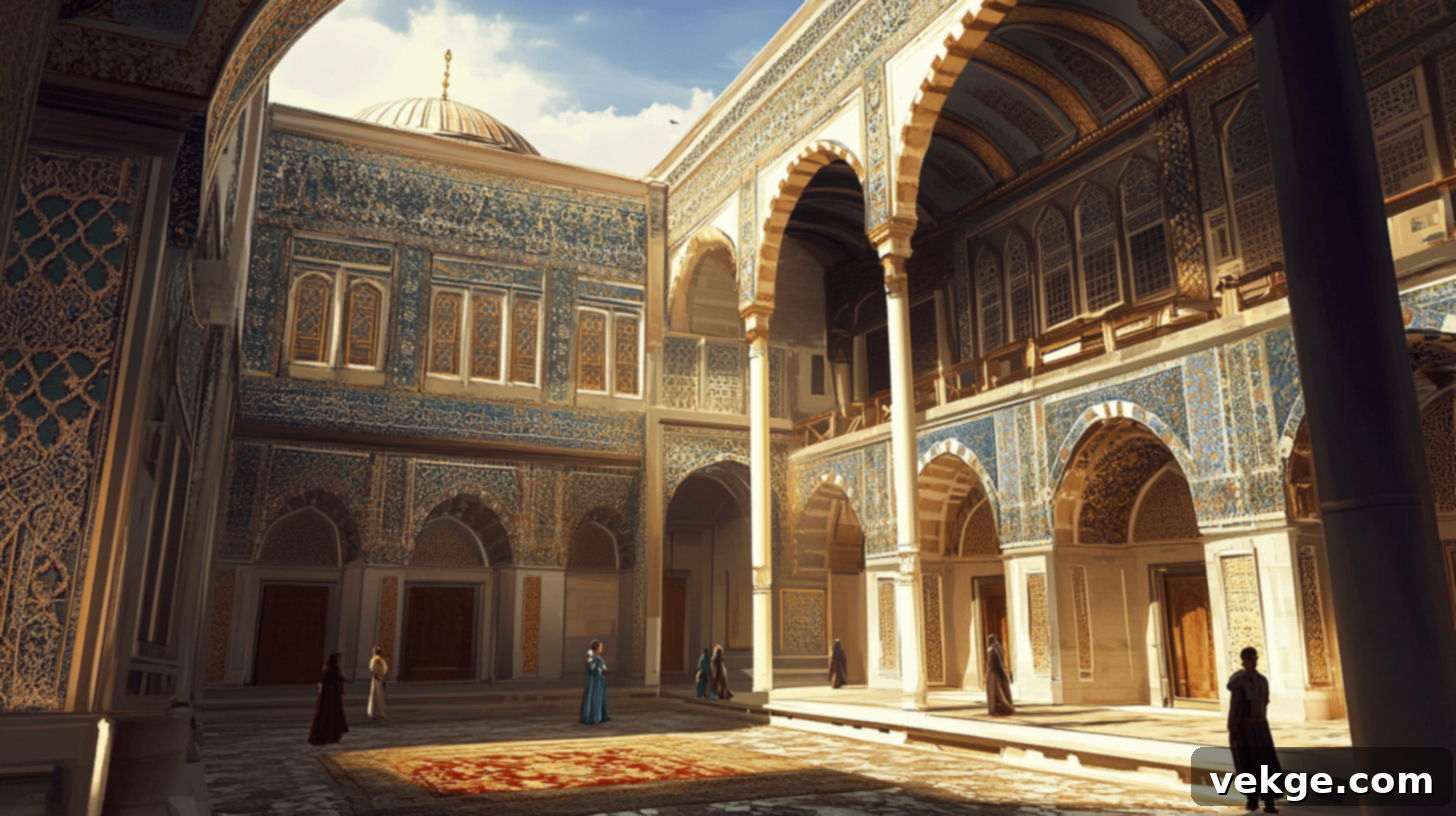
Nestled on a promontory overlooking the Bosphorus, Topkapi Palace was the magnificent administrative and residential heart of the Ottoman Empire for nearly 400 years. This sprawling complex is a city within a city, housing opulent royal apartments, vast imperial kitchens, the sacred treasury, and the legendary Harem. Exploring its courtyards, pavilions, and chambers offers an intimate glimpse into the lives of Ottoman sultans, their courts, and the intricate politics that governed one of the world’s most powerful empires. Each room and exhibit tells a story of power, luxury, and artistic refinement.
- Best Time to Visit: Early spring or fall ensures pleasant temperatures and ideal natural light for photography. Arrive early to avoid queues, especially for the Harem.
- Guided Tours: Palace tours often provide skip-the-line access and fascinating anecdotes about palace life, political intrigues, and the daily routines of the Ottoman elite.
- Entry Fees and Hours: Basic entry is approximately 750 TL, with an additional fee required to access the Harem section. The museum is open from 9 am-6 pm and is closed on Tuesdays.
3. Sultanahmet Mosque (Blue Mosque) – Istanbul
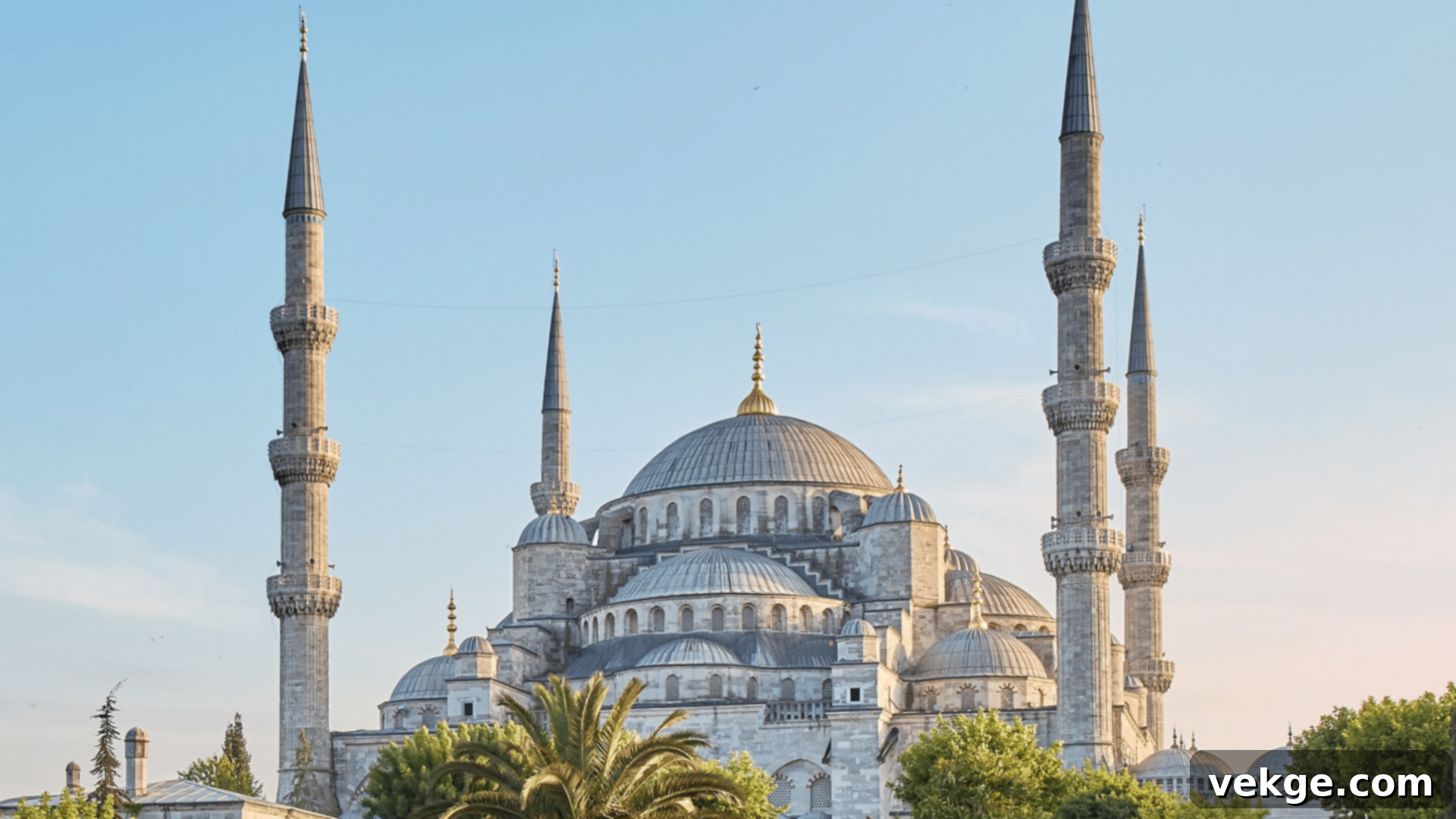
Directly facing Hagia Sophia, the Sultanahmet Mosque, popularly known as the Blue Mosque, is a masterpiece of Ottoman architecture. Completed in 1616, it is renowned for its cascading domes, six slender minarets, and the thousands of exquisite blue Iznik tiles that adorn its interior walls, creating a truly ethereal atmosphere. This imperial mosque exemplifies Ottoman architectural prowess in creating sacred spaces that are both grand and perfectly balanced, symbolizing piety and imperial power. The play of light through its numerous windows on the blue tiles is a sight to behold.
- Best Time to Visit: Mid-morning or late afternoon, ensuring you visit outside of the five daily prayer times. Ramadan offers a uniquely spiritual atmosphere but typically attracts larger crowds.
- Guided Tours: Tours focusing on Islamic art and architecture highlight the mosque’s intricate design features and provide context on religious customs and practices.
- Entry Fees and Hours: Entry is free. It is closed to tourists during prayer times. Women are required to cover their heads; scarves are available to borrow at the entrance.
4. Ephesus – Izmir

Journey back in time at Ephesus, one of the best-preserved ancient Greco-Roman cities in the Mediterranean. Once a bustling port city and a major trade center, its remarkably intact streets, grand Library of Celsus, massive theater, and residential homes offer a vivid portrayal of daily life in the Roman era. Walking through its marble-paved streets, you can almost hear the echoes of ancient footsteps, imagining merchants, philosophers, and citizens going about their day. The Terrace Houses, with their exquisite mosaics and frescoes, reveal the luxurious lifestyles of the wealthy Ephesians.
- Best Time to Visit: April, May, or October offer mild temperatures, making it comfortable to explore the extensive site. Arrive early in the morning to escape the heat and crowds.
- Guided Tours: Archaeological tours are highly recommended to bring the ruins to life with stories and historical context. Some tours include the Terrace Houses (which require an extra fee but are truly worth it).
- Entry Fees and Hours: The main site entry is approximately 900 TL, with an additional charge for the Terrace Houses. Open 8 am-7 pm during summer and 8 am-5 pm in winter.
5. Cappadocia – Nevşehir
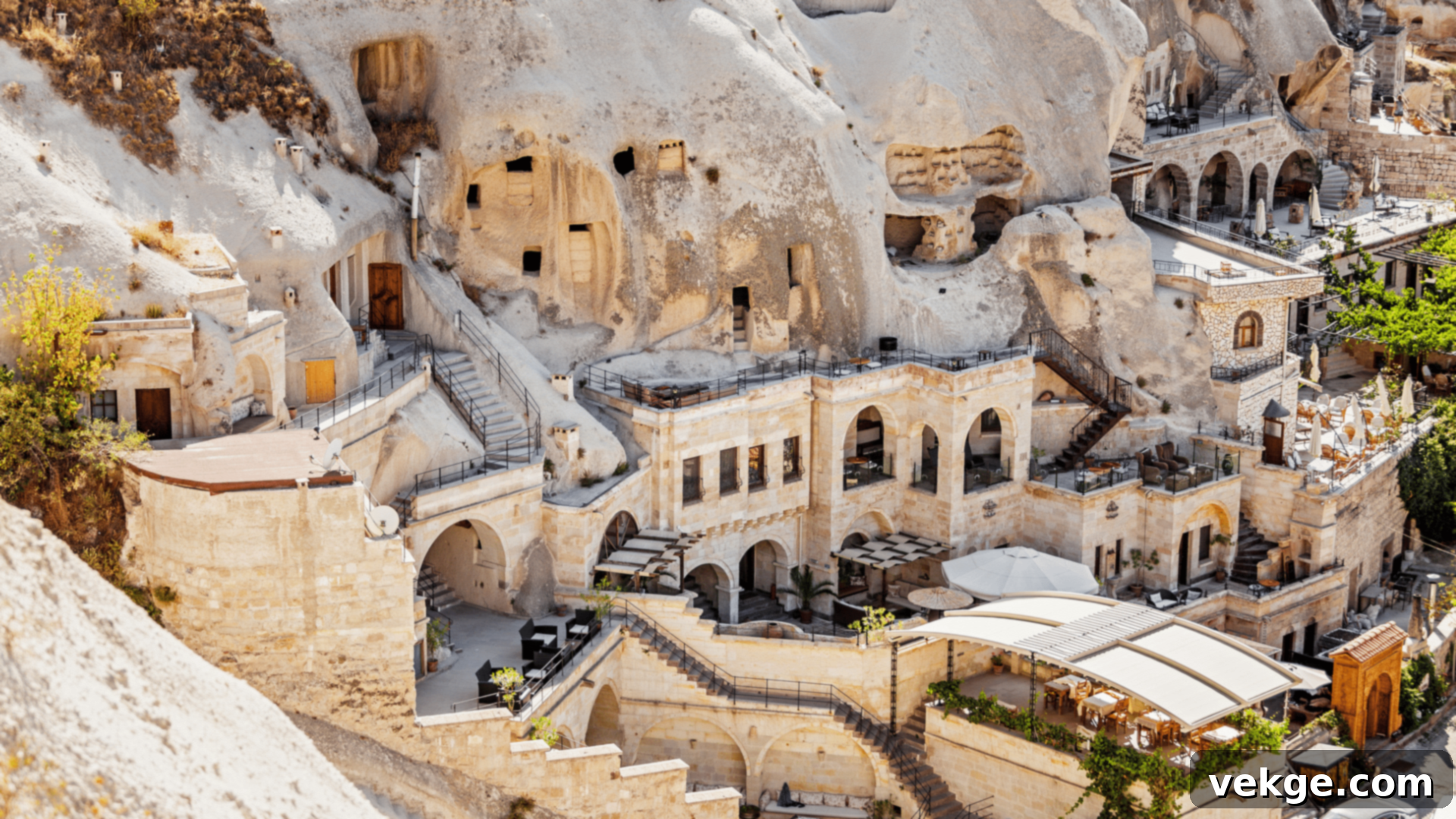
Cappadocia is a region of surreal beauty, famous for its unique “fairy chimney” rock formations, ancient underground cities, and a multitude of cave churches adorned with stunning frescoes. This otherworldly landscape was formed by volcanic ash erosion over millions of years. It became a sanctuary for early Christians who carved out hidden communities, creating elaborate churches and dwellings within the soft rock. The region offers an unparalleled sense of ancient mysticism and natural wonder, especially magical at sunrise.
- Best Time to Visit: April-June and September-October provide pleasant weather for exploring. Winter offers a breathtaking snow-covered landscape, albeit with colder temperatures.
- Guided Tours: A hot air balloon ride at sunrise is a truly iconic and unforgettable experience, offering panoramic views of the entire region. Red, Green, and Blue tours cover different valleys and historical sites within Cappadocia.
- Entry Fees and Hours: Göreme Open Air Museum is around 650 TL. Most sites are open from 8 am-5 pm.
6. Pamukkale – Denizli
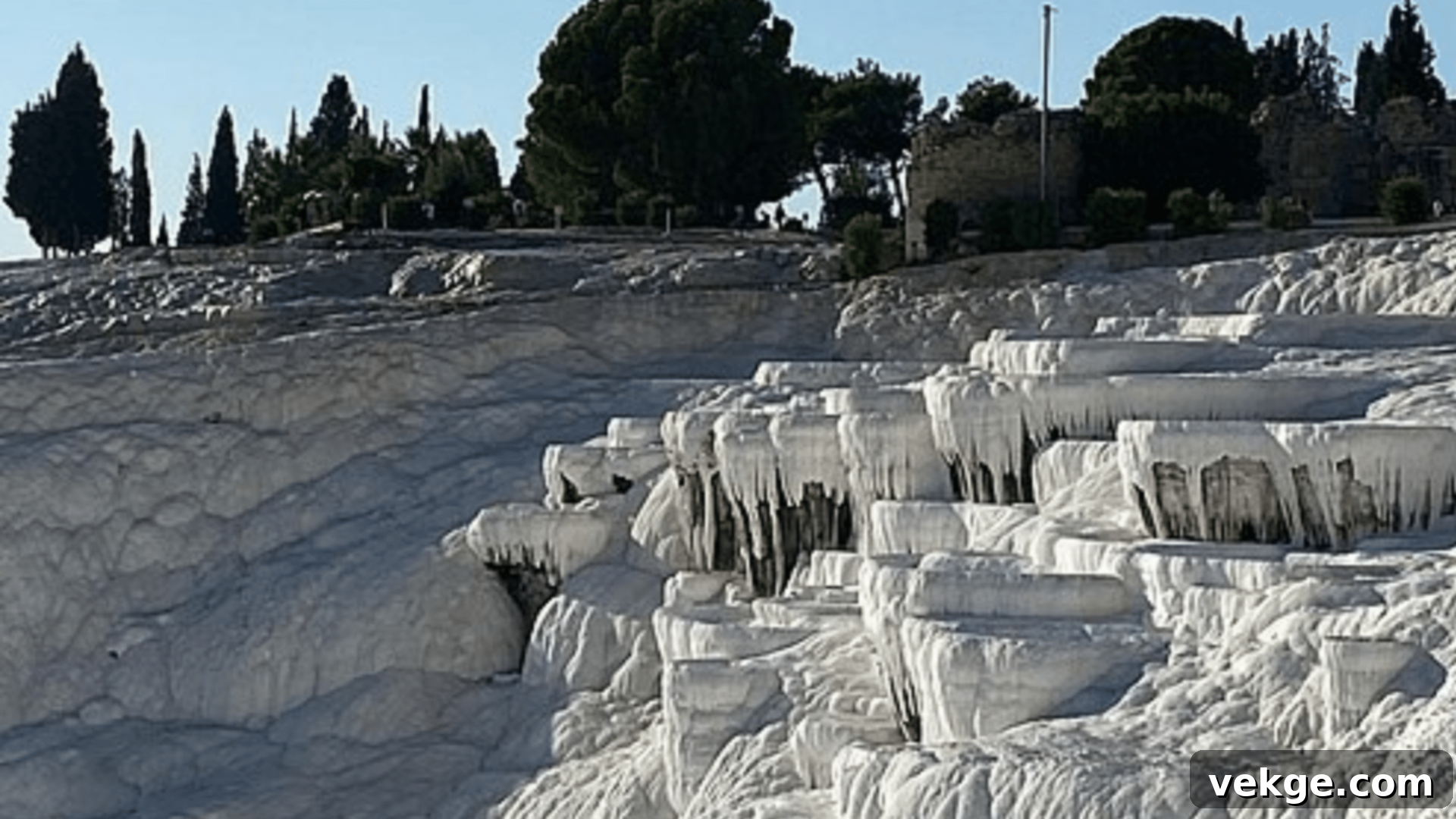
Pamukkale, meaning “Cotton Castle,” is a dazzling natural wonder featuring brilliant white calcium travertines that form terraced pools filled with mineral-rich thermal waters. These striking white terraces cascade down a hillside, creating a landscape that looks almost artificially sculpted. Above this natural marvel lies the ancient Roman spa city of Hierapolis, where Romans once flocked to utilize the supposed healing properties of the waters. Visitors can wade in some of the warm pools and explore the extensive ruins of the ancient city, including a well-preserved theater and necropolis.
- Best Time to Visit: March-May or September-November are ideal, as you can avoid the intense summer heat and larger crowds.
- Guided Tours: Combined tours of the travertines and the Hierapolis archaeological site provide a comprehensive understanding of both the geological formation and ancient history.
- Entry Fees and Hours: A combined ticket for both the travertines and Hierapolis is approximately 650 TL. Open from 6:30 am-9 pm in summer, and 8 am-5 pm in winter.
7. Sumela Monastery – Trabzon

Perched dramatically on a sheer cliff face within the Pontic Mountains near Trabzon, the Sumela Monastery is a breathtaking Greek Orthodox monastic complex. Founded in the 4th century, its construction into the rock face is a marvel of engineering and perseverance. The monastery is adorned with ancient frescoes that showcase sophisticated Byzantine art techniques, preserving religious narratives and artistic styles in a stunningly remote mountain setting. The journey to the monastery itself, through lush forests, is part of the experience.
- Best Time to Visit: June-September, when mountain roads are most accessible and the weather is favorable for exploring.
- Guided Tours: Full-day tours from Trabzon often incorporate other significant Black Sea region sites, offering a broader cultural experience.
- Entry Fees and Hours: Approximately 10 TL. Open 9 am-7 pm in summer, 9 am-4 pm in winter. Closed on Mondays.
8. Mount Nemrut – Adıyaman
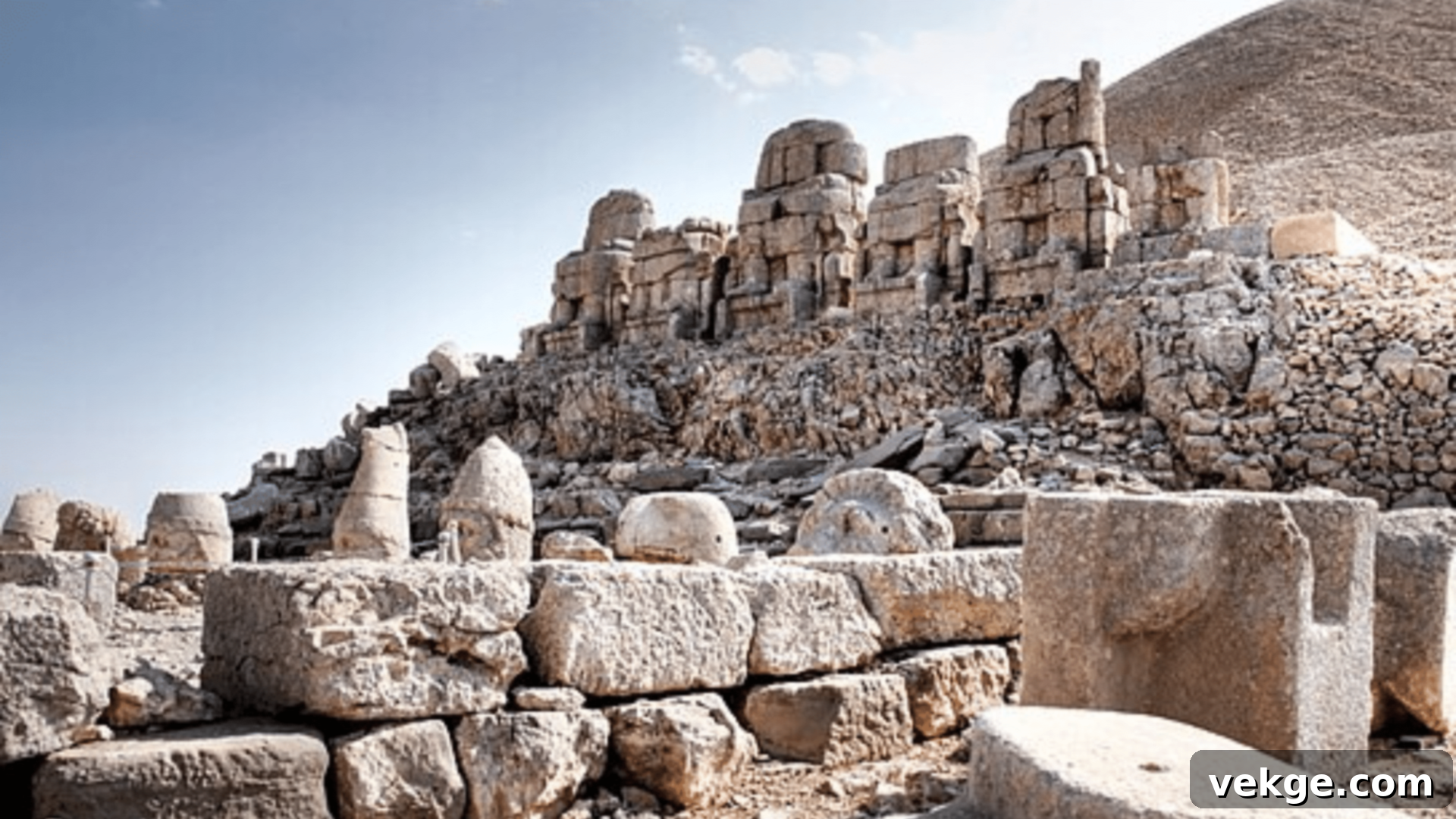
A UNESCO World Heritage site, Mount Nemrut is home to an extraordinary mountaintop sanctuary created by King Antiochus I Theos of Commagene in the 1st century BCE. This unique site features colossal stone heads of gods and King Antiochus himself, reflecting a fascinating blend of Persian, Armenian, and Greek cultures that defined his kingdom. The giant statues, now mostly toppled from their bodies, create a profoundly dramatic and mysterious atmosphere, especially at dawn or dusk when the light bathes them in an ethereal glow.
- Best Time to Visit: May to October. Sunrise and sunset offer the most spectacular views and lighting conditions for photography, making the experience truly magical.
- Guided Tours: Sunrise or sunset tours are immensely popular, often including convenient hotel pickup from nearby towns.
- Entry Fees and Hours: Approximately 150 TL. Open from 8 am-8 pm in summer.
9. Troy – Çanakkale
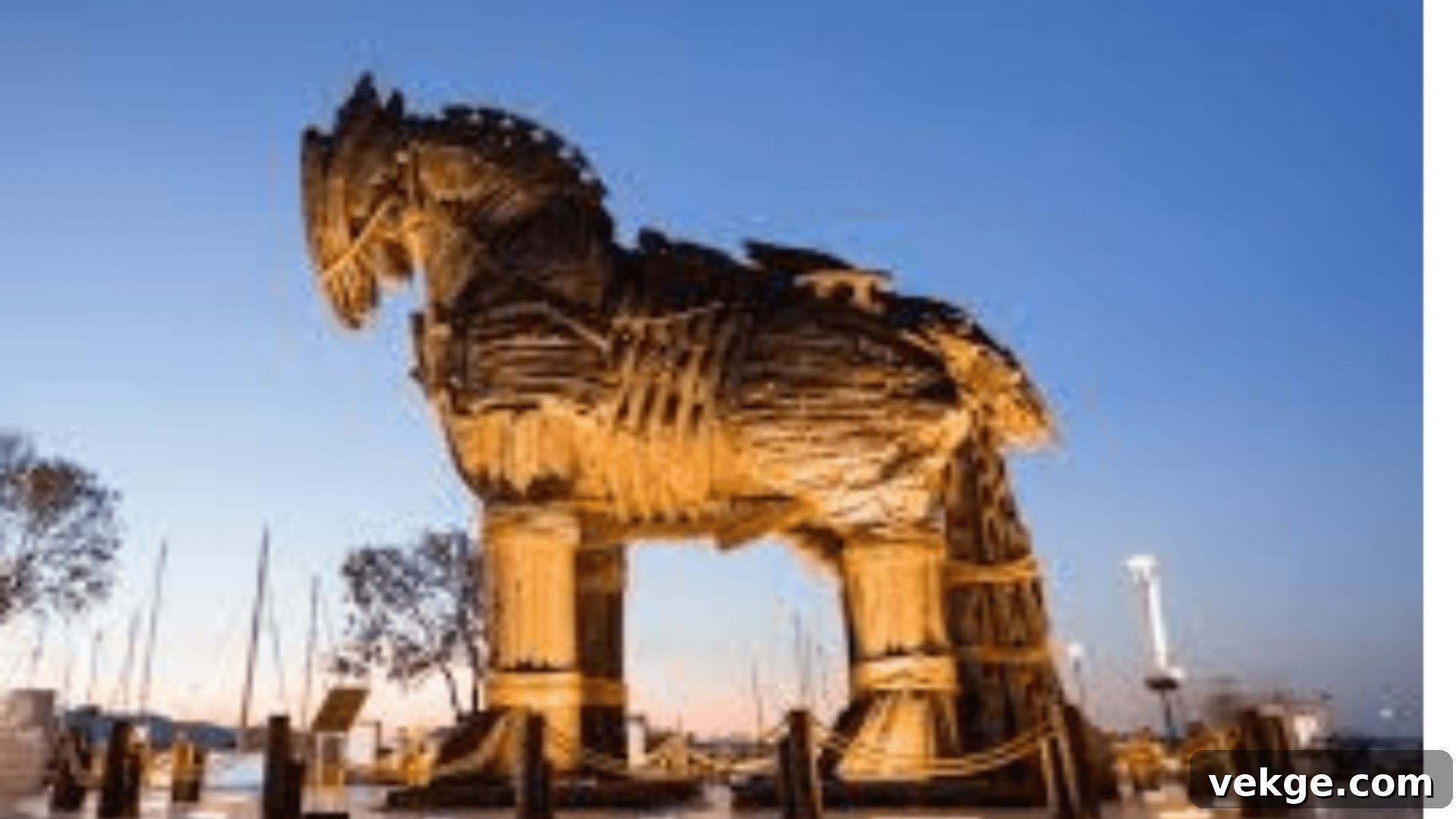
The legendary site of the Trojan War, immortalized in Homer’s Iliad, Troy is a place where myth and history intertwine. Archaeological excavations have revealed nine layers of ancient cities, built one atop another over thousands of years. These layers offer a fascinating timeline of human settlement and early urban planning from the Bronze Age through the Roman period. While perhaps not as visually striking as some other ruins, the sheer historical weight of Troy, coupled with the reconstructed wooden Trojan Horse, makes it a powerful destination for anyone interested in ancient legends and archaeology.
- Best Time to Visit: April-May and September-October offer mild weather perfect for exploring the extensive site.
- Guided Tours: Historical tours are invaluable here, helping visitors discern which ruins belong to which period and expertly connecting them to Homer’s epic tales.
- Entry Fees and Hours: Approximately 150 TL. Open from 8:30 am-6:30 pm (with extended hours during the peak summer season).
10. Pergamum (Pergamon) – Izmir
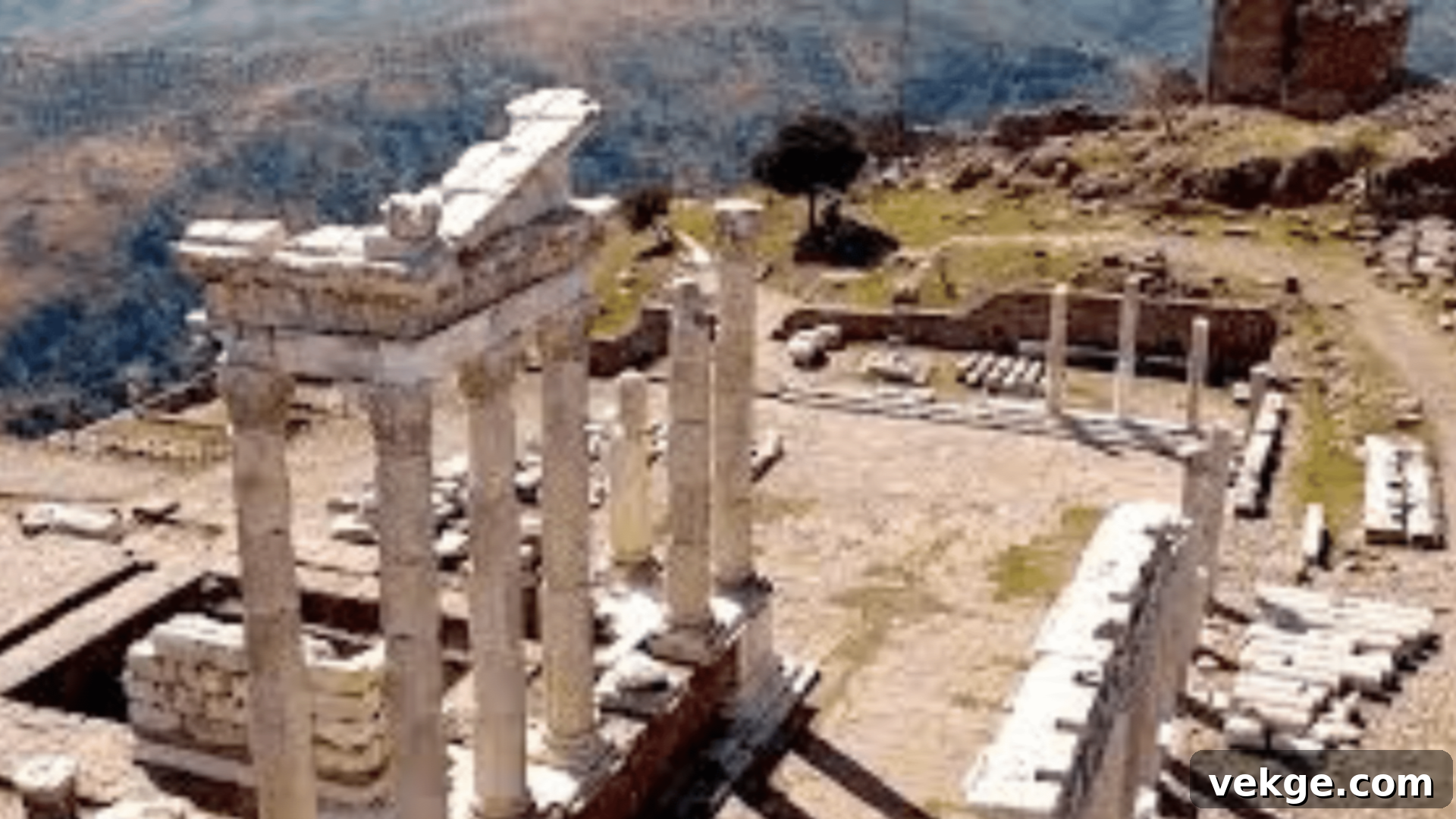
Pergamum, an ancient Greek city, was once a thriving center of Hellenistic culture, known for its intellectual and architectural achievements. Perched atop a hill, its impressive Acropolis features an extraordinarily steep theater, ingeniously built into the natural slope, offering breathtaking views. The city was also home to a massive library, second only to Alexandria, and a renowned medical school (the Asklepion). Pergamum epitomizes the peak of Hellenistic civilization, boasting sophisticated urban planning, advanced knowledge, and stunning artistic endeavors.
- Best Time to Visit: April-May and September-October for comfortable temperatures, ideal for climbing the Acropolis.
- Guided Tours: Combined tours of the Acropolis and the Asklepion (the ancient medical center) provide a holistic view of Pergamum’s political, cultural, and scientific significance.
- Entry Fees and Hours: Entry to the site is free, but timings may vary. It’s advisable to check locally.
11. Ruins of Aphrodisias – Aydın
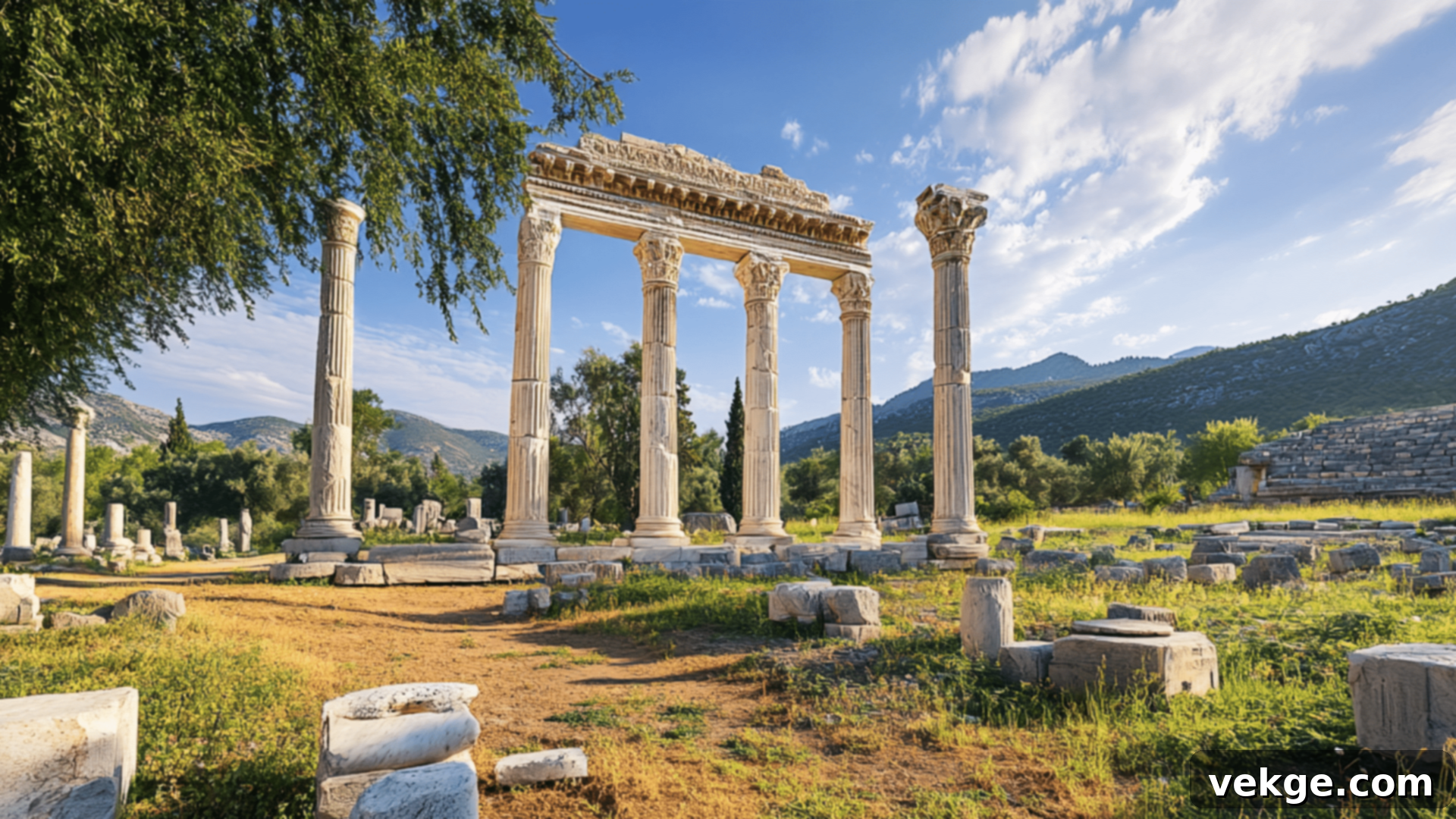
Dedicated to Aphrodite, the goddess of love, beauty, pleasure, and procreation, the ancient city of Aphrodisias is a UNESCO World Heritage site celebrated for its exceptionally well-preserved structures and exquisite marble sculptures. It boasts an impressive stadium, a grand theater, and a sculpture workshop, testament to its fame as a center for marble carving. The quality and abundance of the statuary found here are unparalleled, offering a profound insight into ancient artistry and the cult of Aphrodite. The site is less crowded than Ephesus, allowing for a more serene exploration.
- Best Time to Visit: Spring and fall offer mild weather and fewer visitors, allowing for a more intimate experience of the ruins.
- Guided Tours: Archaeological tours can illuminate the intricate details of the sculptures and explain the ancient sports and cultural events held at the stadium.
- Entry Fees and Hours: Entry is typically 10-15 TL. Open 8 am-7 pm in summer, and 8:30 am-5 pm in winter.
12. Ani – Kars

Known as the “City of 1001 Churches,” Ani is a mesmerizing medieval Armenian ghost city located on the remote Turkish-Armenian border. Once a thriving capital and a major Silk Road trade hub, its ruins include majestic churches, a mosque, and imposing city walls that tell tales of its past glory and cultural fusion. The desolate beauty of Ani, with its diverse architectural styles, showcases the wealth and cultural sophistication that resulted from its strategic position between empires. It’s a poignant and powerful reminder of a once-vibrant civilization.
- Best Time to Visit: June to September, when eastern Turkey experiences milder and more pleasant weather conditions for exploration.
- Guided Tours: Historical tours offer valuable insights into the city’s rise and fall, placing it within the broader context of Armenian and Byzantine history.
- Entry Fees and Hours: Approximately 180 TL. Open 8 am-7 pm in summer, with shorter hours during the winter months.
13. Aspendos Theatre – Antalya
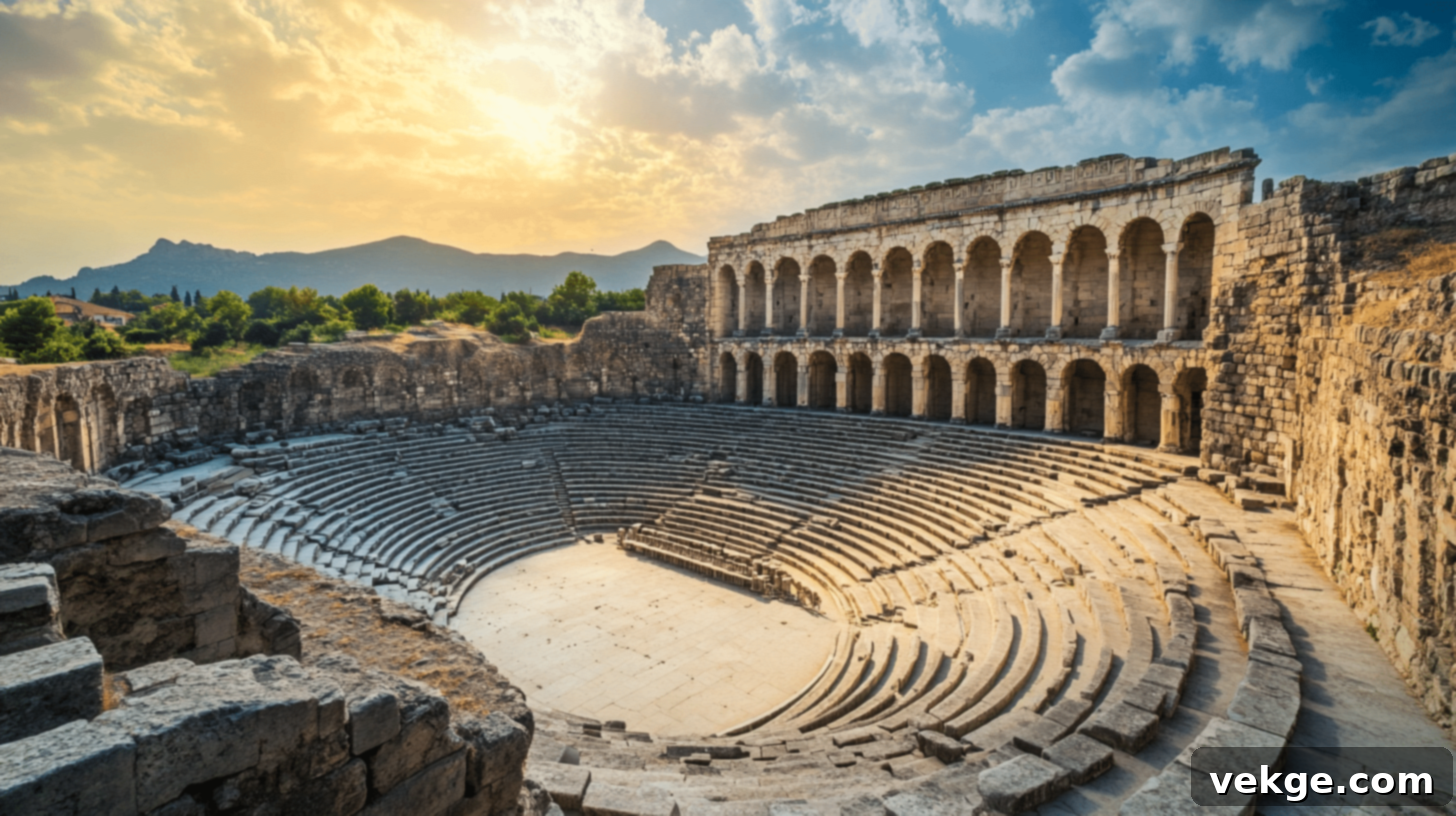
The Aspendos Theatre is widely regarded as one of the best-preserved ancient Roman theaters in the world. Its nearly intact stage building and tiered seating bowl are a testament to Roman engineering and architectural genius. The theater’s remarkable acoustics mean it is still utilized today for performances, most notably the annual Aspendos International Opera and Ballet Festival. Attending a performance here offers a truly unique opportunity to experience history come alive, just as audiences did nearly two millennia ago.
- Best Time to Visit: May and September-October for pleasant weather. Check local schedules for summer opera and ballet festivals for an unforgettable experience.
- Guided Tours: Architectural tours can provide fascinating details about Roman theater design, acoustic principles, and the history of performances held here.
- Entry Fees and Hours: Approximately 200 TL. Open 9:30 am-4:30 pm in summer, with shorter hours in winter.
14. Bodrum Castle – Bodrum

Dominating the harbor of Bodrum, this formidable castle was constructed by the Knights of St. John in the 15th century, famously utilizing stones salvaged from the Mausoleum of Halicarnassus, one of the Seven Wonders of the Ancient World. Today, Bodrum Castle houses the world-renowned Museum of Underwater Archaeology, which showcases an incredible collection of ancient shipwrecks, artifacts recovered from the seabed, and insights into ancient maritime trade. The castle itself is a fascinating structure to explore, with its towers and ramparts offering panoramic views of the Aegean Sea.
- Best Time to Visit: April-May and September-October are ideal to avoid the intense summer heat and large crowds, making exploration more comfortable.
- Guided Tours: Museum tours offer captivating explanations of ancient maritime trade routes, shipwreck discoveries, and the sophisticated technology used in underwater archaeology.
- Entry Fees and Hours: Approximately 25 TL. Open 8:30 am-4:30 pm, closed on Mondays.
15. Safranbolu – Karabük
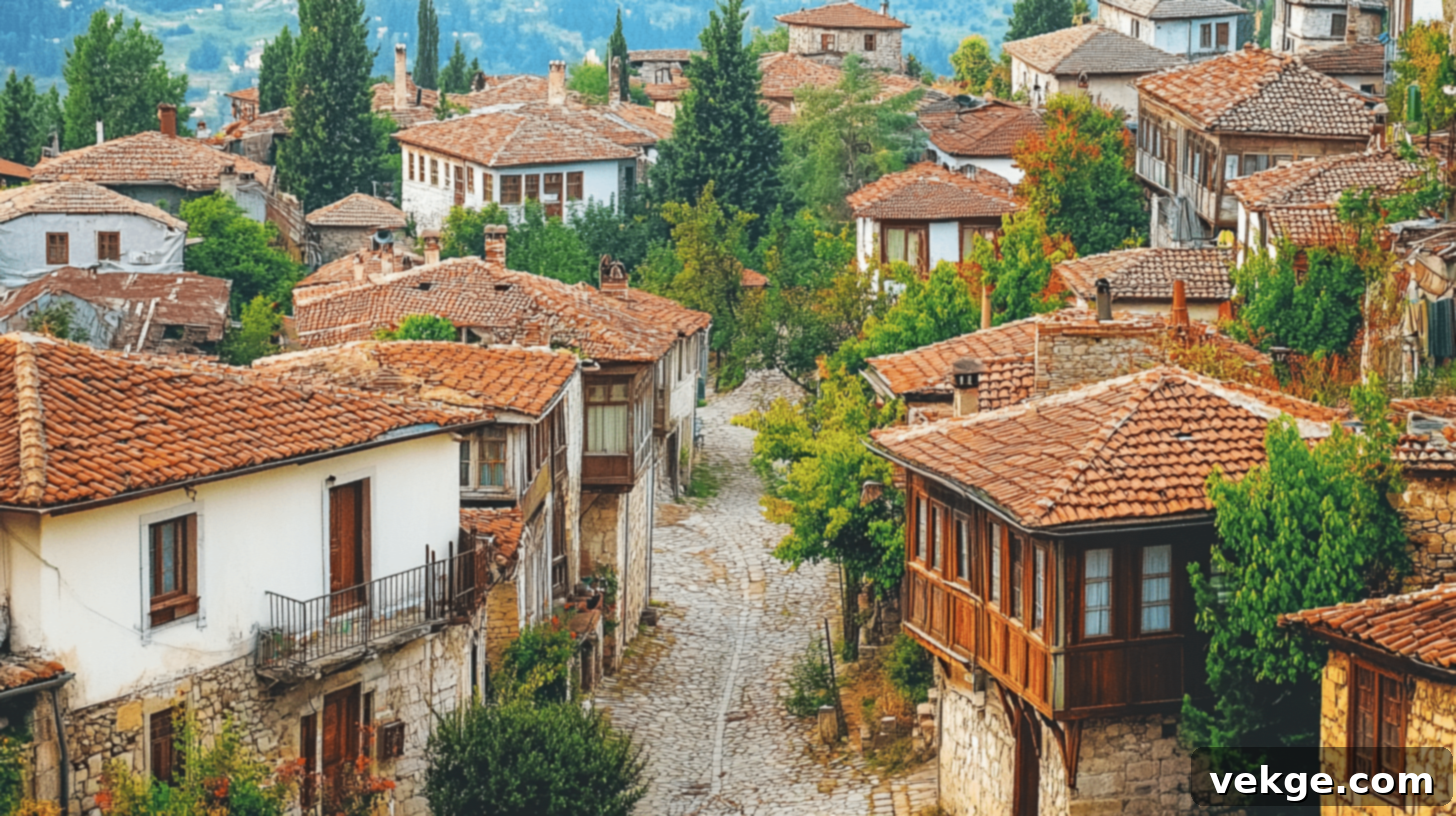
Safranbolu is a remarkably preserved Ottoman trading town, designated a UNESCO World Heritage site, famous for its distinctive Ottoman-era wooden houses. These meticulously maintained examples of traditional Turkish architecture offer a vivid window into the daily life and prosperity of wealthy Turkish families during the 18th and 19th centuries. Strolling through its narrow cobblestone streets, you can admire the intricate craftsmanship, visit historic mosques, hammams, and caravanserai, all contributing to an atmosphere that feels like stepping back in time. The town’s historical charm is truly captivating.
- Best Time to Visit: April-June and September-October offer the most pleasant weather for exploring the charming streets and Ottoman architecture.
- Guided Tours: Walking tours of the old town provide excellent insights into Ottoman urban planning, social structures, and daily life in this historical trading hub.
- Entry Fees and Hours: Many of the historic houses operate as museums or guesthouses and charge small entry fees (15-30 TL). They are generally open from 9 am-7 pm.
16. Oludeniz (Blue Lagoon) – Muğla
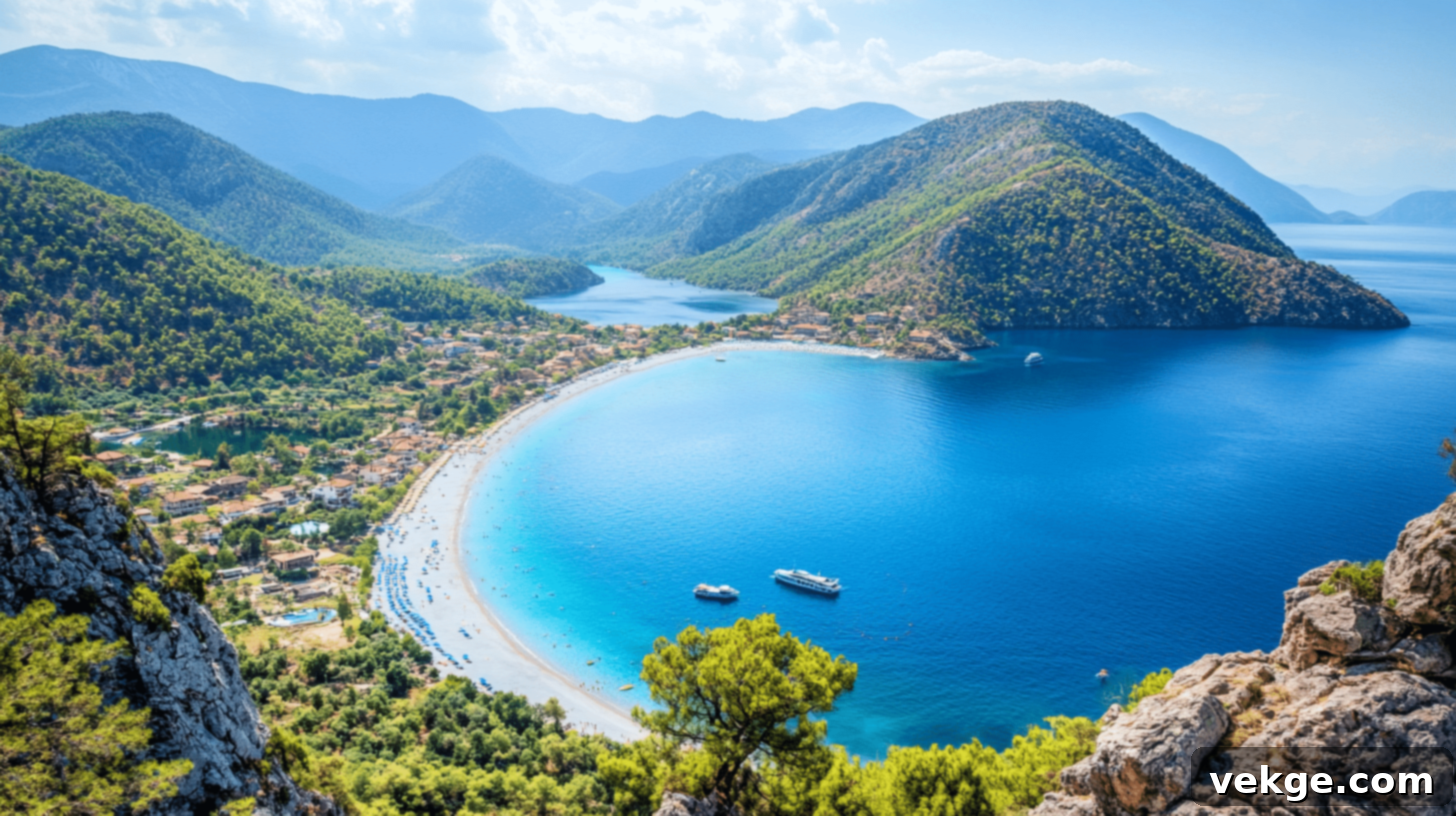
Oludeniz, famously known as the Blue Lagoon, is one of Turkey’s most iconic natural wonders and a postcard-perfect destination. This stunning natural bay is characterized by its exceptionally calm, shimmering turquoise waters and pristine white sand beach, framed by dramatic pine-clad mountains. It’s a place where the majestic mountains meet the tranquil sea, creating a breathtaking landscape frequently ranked among the world’s top beaches. Beyond swimming and sunbathing, Oludeniz is also a renowned global hub for paragliding, offering unparalleled aerial views.
- Best Time to Visit: May-June and September-October are ideal for enjoying swimming and beach activities without the peak summer crowds.
- Guided Tours: Boat tours are popular for visiting hidden coves, Butterfly Valley, and nearby islands. Tandem paragliding from the towering Babadağ mountain offers an exhilarating perspective of the lagoon.
- Entry Fees and Hours: The main beach is free. Access to the protected Blue Lagoon National Park is approximately 250 TL.
17. Mausoleum of Mevlana Rumi – Konya
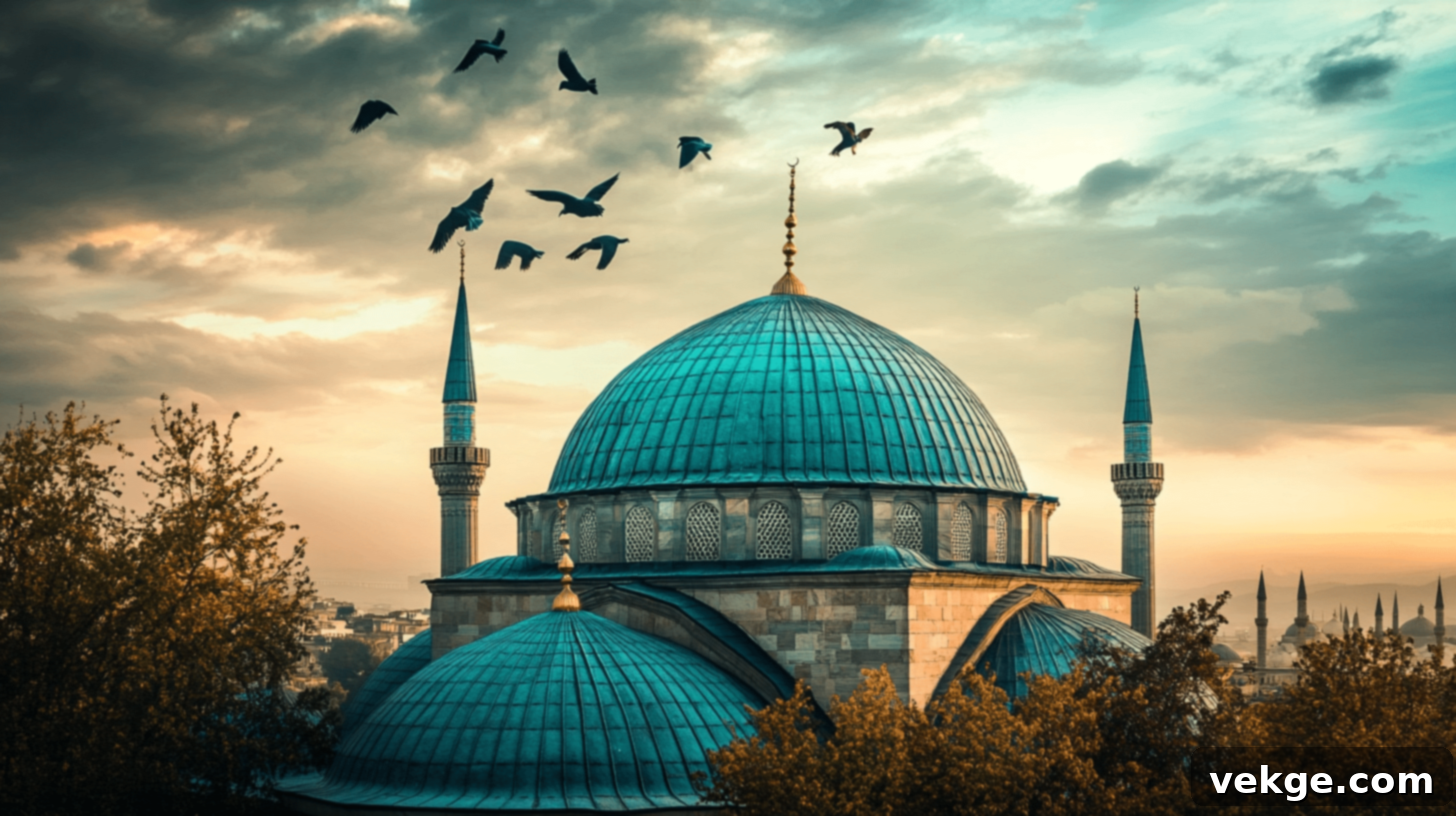
The Mevlana Museum, located in Konya, houses the tomb of the illustrious 13th-century Sufi poet, scholar, and philosopher, Jelaluddin Rumi. This spiritual complex serves as the heart of the whirling dervish tradition and a significant center for Islamic mystical teachings, attracting pilgrims and admirers from across the globe. The iconic fluted green dome covers Rumi’s tomb, and the museum beautifully displays artifacts related to the Mevlevi Order, including musical instruments, clothing, and manuscripts. It is a place of profound peace and spiritual reflection.
- Best Time to Visit: December is particularly special for attending the annual “Şeb-i Arus” ceremonies, which commemorate Rumi’s death with mesmerizing whirling dervish performances.
- Guided Tours: Cultural and historical tours provide deep insights into Sufi traditions, Rumi’s timeless poetry, and the philosophical underpinnings of the Mevlevi Order.
- Entry Fees and Hours: Entry to the museum is free. It is typically open from 9 am-5:30 pm, closed on Mondays.
18. Van Lake – Van
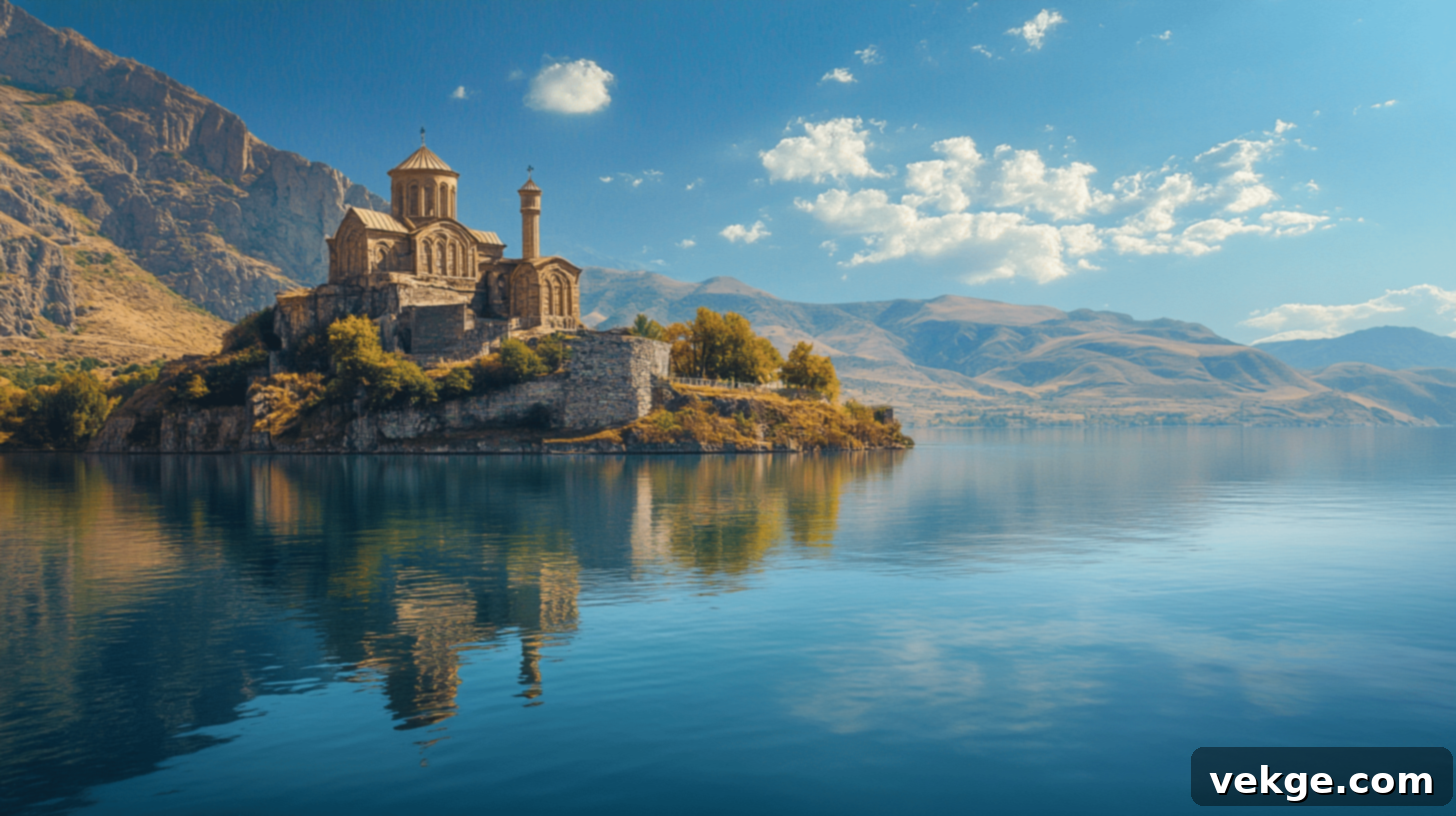
Van Lake, the largest lake in Turkey and a soda lake, is a captivating natural landmark in Eastern Anatolia. Its deep blue waters are dotted with islands, the most famous of which is Akdamar Island, home to the exquisitely preserved 10th-century Armenian Akdamar Church. This region is also renowned for its unique breed of “Van cats,” famous for their striking heterochromia (different-colored eyes) and unusual love for swimming. The lake and its surroundings offer a rich blend of natural beauty, ancient history, and distinctive local culture.
- Best Time to Visit: June-September, when Eastern Turkey enjoys pleasant weather, making boat trips and explorations comfortable.
- Guided Tours: Boat tours to Akdamar Island are a highlight. Some tours also incorporate visits to Van Castle and other nearby historical sites, providing a broader historical context.
- Entry Fees and Hours: The boat fee to Akdamar Island is around 50 TL, plus a 100 TL entrance ticket for the church. Open 8 am-7 pm in summer.
19. Myra Ruins – Demre
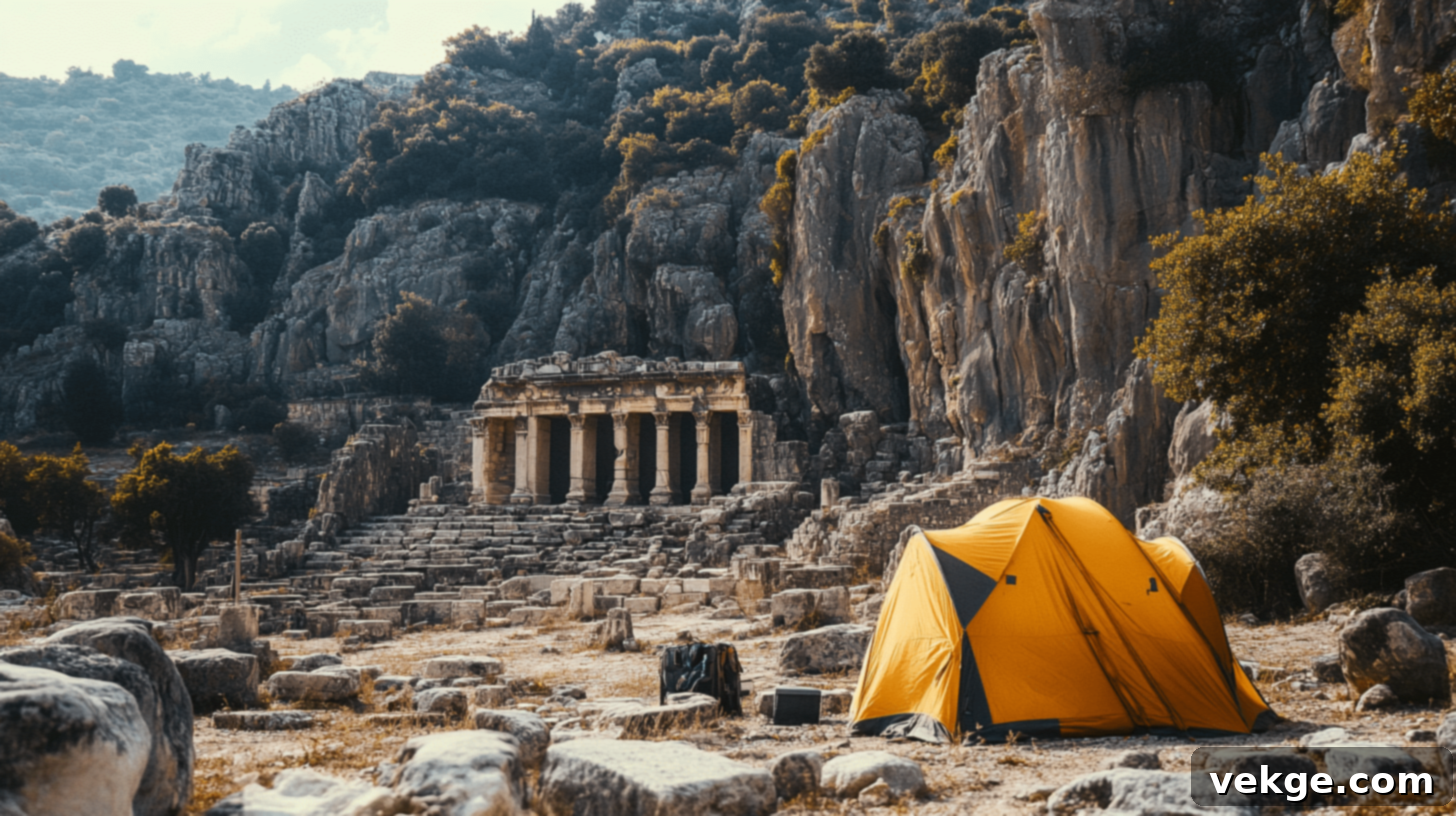
The ancient Lycian city of Myra is renowned for its fascinating rock-cut tombs, carved directly into the cliff face overlooking a remarkably large and well-preserved Roman theater. These ornate tombs, resembling temple facades, are a striking example of Lycian funerary art. Myra holds particular significance in Christian history, as St. Nicholas (the historical figure behind Santa Claus) served as bishop here in the 4th century. Exploring these ruins offers a compelling glimpse into both pagan Lycian traditions and early Christian history along Turkey’s Mediterranean coast.
- Best Time to Visit: April-May and October offer mild temperatures, ideal for exploring the open-air archaeological site.
- Guided Tours: Combined tours of the Myra ruins and the St. Nicholas Church in Demre provide a comprehensive overview of both the ancient pagan and early Christian history of the region.
- Entry Fees and Hours: Approximately 70 TL. Open 8:30 am-7 pm in summer, and 8:30 am-5 pm in winter.
20. Grand Bazaar – Istanbul

More than just a market, the Grand Bazaar in Istanbul is one of the world’s oldest and largest covered markets, a vibrant labyrinth that has been operating continuously since 1461. With over 4,000 shops spread across 61 covered streets, it’s a sensory feast where you can find everything from intricate hand-knotted carpets and shimmering gold jewelry to exquisite ceramics, spices, and traditional Turkish delights. It’s not just a shopping destination but a historical and cultural experience, offering a glimpse into centuries of trade and craftsmanship. Haggling is part of the fun!
- Best Time to Visit: Weekday mornings are best to avoid the densest crowds. Be aware that some shops may close on Sundays.
- Guided Tours: Shopping tours can help navigate the vast bazaar, offering tips for haggling and guiding you to quality goods. Food tours also explore the culinary delights hidden within and around the bazaar.
- Entry Fees and Hours: Entry is free. Open 8:30 am-7 pm, closed on Sundays.
21. Manavgat Waterfalls – Antalya

Nestled near the popular tourist hub of Antalya, the Manavgat Waterfalls are a series of small, yet broad and powerful waterfalls cascading over a wide area. While not dramatically high, their sheer breadth creates a captivating natural spectacle. The surrounding area is a popular spot for locals and tourists alike to enjoy picnics, relax by the cool waters, and even take a refreshing dip. It’s a tranquil escape from the coastal heat, showcasing Turkey’s accessible natural beauty and providing a serene environment for relaxation.
- Best Time to Visit: May-June and September, when the water flow is strong from seasonal rains, but the tourist crowds are lighter than in peak summer.
- Guided Tours: River boat tours often include a stop at the falls, sometimes combining it with visits to nearby beaches or the ancient city of Side for a well-rounded day trip.
- Entry Fees and Hours: Approximately 20 TL for adults and 10 TL for children. Open 8 am-7 pm.
22. Mount Ararat – Iğdır
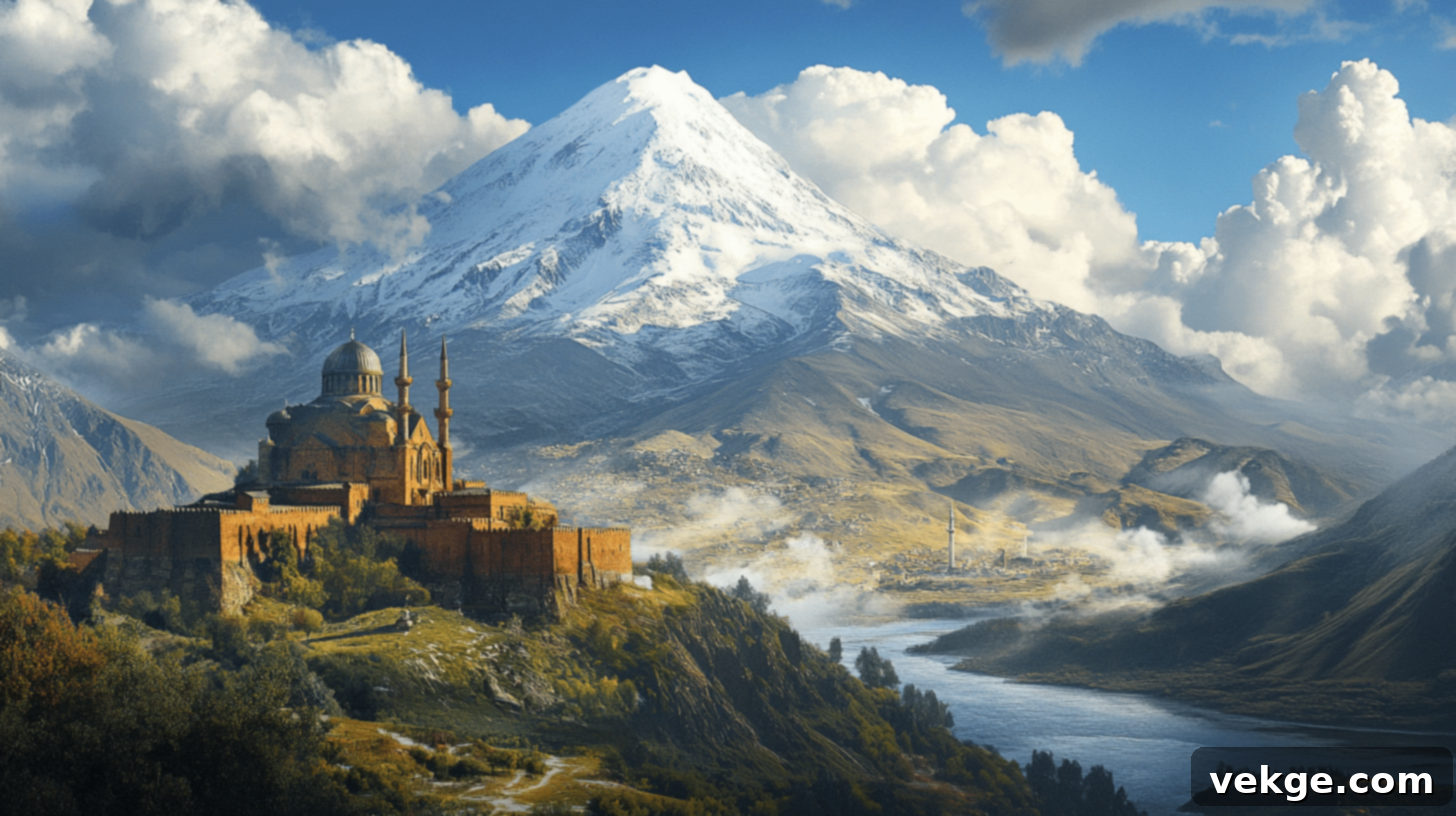
Mount Ararat, a majestic snow-capped dormant volcano, stands as Turkey’s highest peak, soaring to an impressive 5,137 meters (16,854 feet). Beyond its geological significance, it holds immense biblical importance, traditionally identified as the landing place of Noah’s Ark. This iconic mountain dominates the landscape of eastern Turkey and holds deep cultural reverence for both Kurdish and Armenian communities. While climbing requires serious preparation and permits, simply viewing its awe-inspiring presence from a distance is a memorable experience, embodying ancient legends and natural grandeur.
- Best Time to Visit: July-August is the prime climbing season for experienced mountaineers. For those who wish to admire it from afar, June-September offers the clearest views.
- Guided Tours: Climbing expeditions require special permits and certified guides, which must be arranged weeks in advance through authorized Turkish agencies. Most Eastern Turkey tours offer opportunities to view the mountain from scenic viewpoints.
- Entry Fees and Hours: Climbing permits are mandatory and subject to strict regulations.
23. Gallipoli Peninsula – Çanakkale
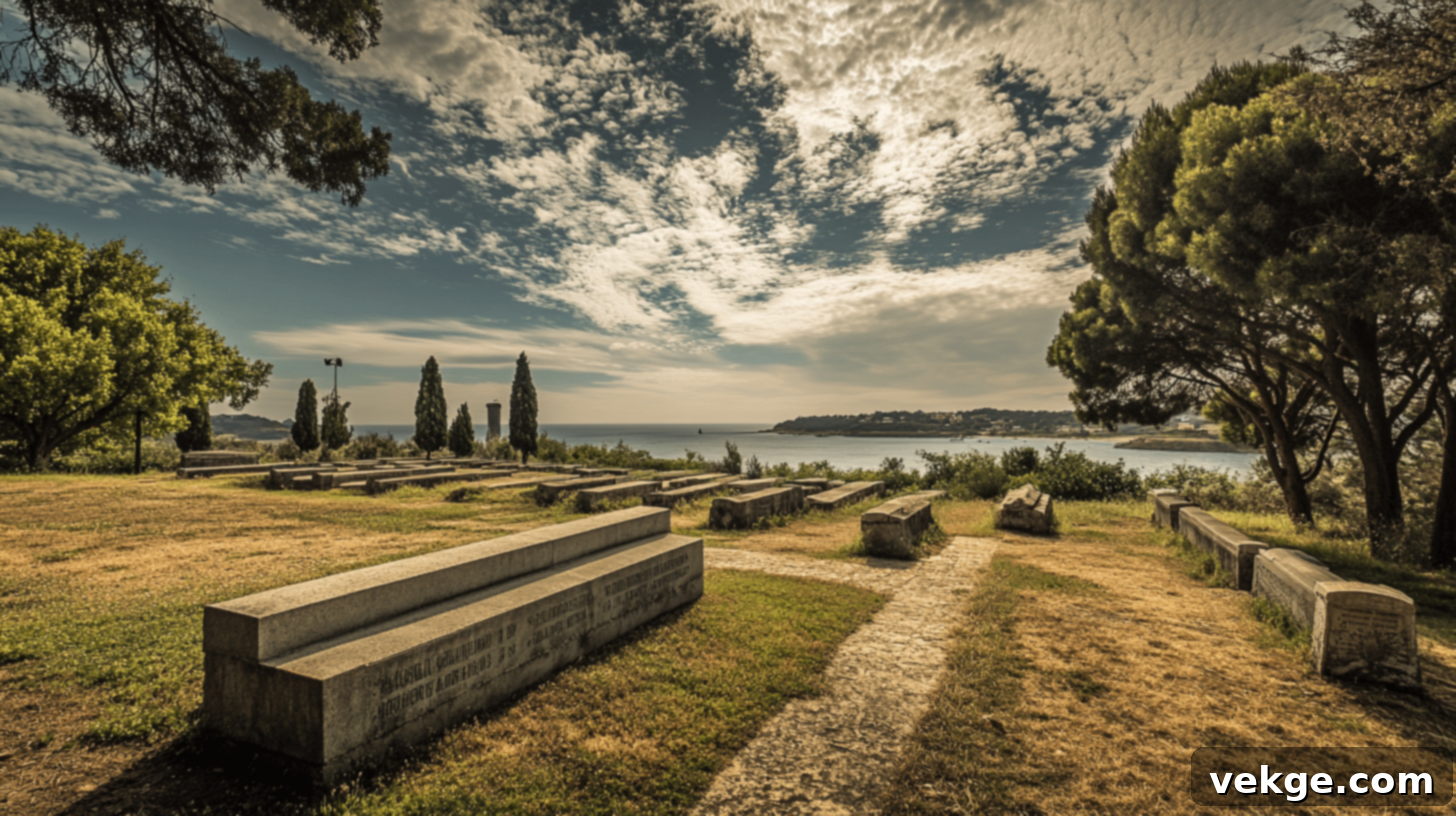
The Gallipoli Peninsula holds profound historical significance as the site of a pivotal World War I campaign in 1915, where Ottoman forces valiantly defended against an Allied invasion. Today, it stands as a poignant peace park, encompassing numerous cemeteries and monuments dedicated to the soldiers from all sides who lost their lives. Visiting Gallipoli is a solemn and moving experience, offering a deep understanding of the human cost of war and the incredible resilience displayed during the conflict. It’s a place of remembrance and respect, beautifully maintained.
- Best Time to Visit: April 25th for the annual ANZAC Day ceremonies, which attract international visitors. Otherwise, spring and fall offer mild weather for respectful exploration.
- Guided Tours: Battlefield tours are highly informative, providing detailed explanations of military strategies, key sites, and deeply personal human stories from the campaign.
- Entry Fees and Hours: Entry to the memorial sites is free. Most sites are typically open from 8:30 am-5 pm.
24. Celsus Library – Ephesus

An architectural marvel within the ancient city of Ephesus, the Celsus Library was once an impressive Roman library built in honor of Tiberius Julius Celsus Polemaeanus. Originally housing an astonishing 12,000 scrolls, its grand two-story facade has been meticulously restored, showcasing the exquisite detail and scale of ancient public architecture. The statues in the niches of the facade represent the virtues of Celsus: Sophia (wisdom), Arete (virtue), Ennoia (thought), and Episteme (knowledge). It remains one of the most iconic and frequently photographed structures in Ephesus.
- Best Time to Visit: April, May, or October. Early morning visits are highly recommended for capturing stunning photos without the bustling crowds.
- Guided Tours: The library is a central feature of all Ephesus tours. Some guides thoughtfully time visits to coincide with the best photography light, enhancing the visual experience.
- Entry Fees and Hours: Access to the Celsus Library is included with the main Ephesus ticket (approximately 900 TL).
25. Basilica Cistern – Istanbul

Beneath the bustling streets of Istanbul lies the awe-inspiring Basilica Cistern, an ancient underground water storage system commissioned by Emperor Justinian I in 532 CE. This subterranean marvel is often called the “Sunken Palace” due to its cavernous, cathedral-like atmosphere created by a forest of 336 ancient marble columns, many repurposed from older temples. The dim lighting, echoing drips of water, and mysterious Medusa head bases create a truly unique and atmospheric experience, transporting visitors to a hidden world beneath the city.
- Best Time to Visit: Any time of year, as its underground location means weather is not a factor. Visiting in the morning helps avoid longer queues.
- Guided Tours: Combined tours with other Byzantine sites often explain the complex engineering of Istanbul’s ancient water systems and the cistern’s role.
- Entry Fees and Hours: Entry is approximately 900 TL. Open daily from 9 am-7 pm.
26. Hattusha (Hattusa) – Çorum
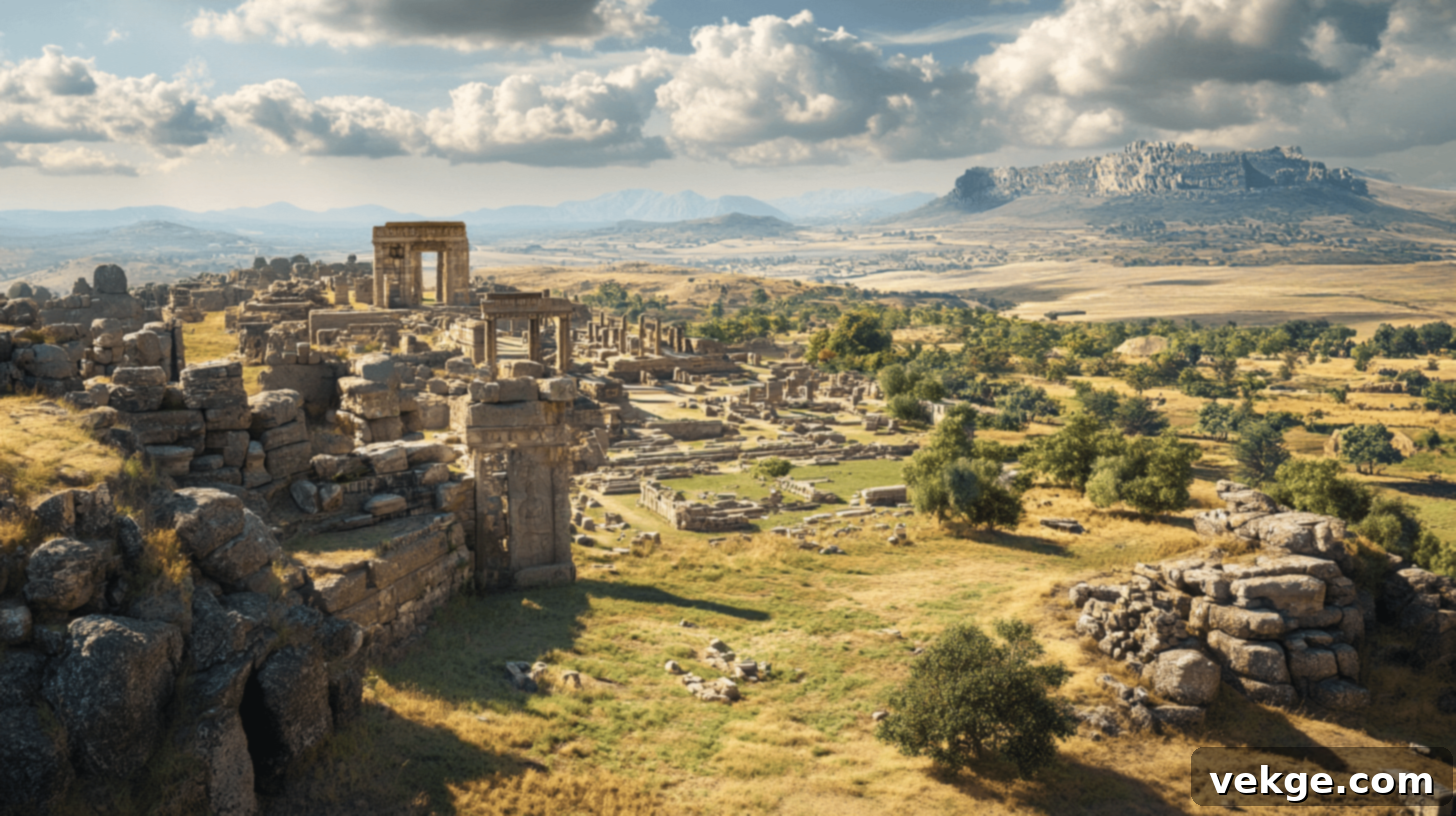
Hattusha, a UNESCO World Heritage site, was the formidable capital of the ancient Hittite Empire, one of the great powers of the Late Bronze Age. This impressive archaeological site features massive defensive walls, grand temples, and meticulously preserved cuneiform archives, which shed light on the Hittites’ legal, diplomatic, and religious practices. Exploring Hattusha offers profound insights into early urban planning, engineering prowess, and the daily life of a powerful Bronze Age civilization, including its innovative use of fortified gates and underground passages.
- Best Time to Visit: May-June and September offer comfortable temperatures for extensive exploration of the site.
- Guided Tours: Archaeological tours are highly recommended to understand the scale and significance of Hittite culture and their empire-building achievements.
- Entry Fees and Hours: Approximately 150 TL. Open 8 am-7 pm in summer, and 8:30 am-5 pm in winter.
27. The Temple of Artemis – Ephesus
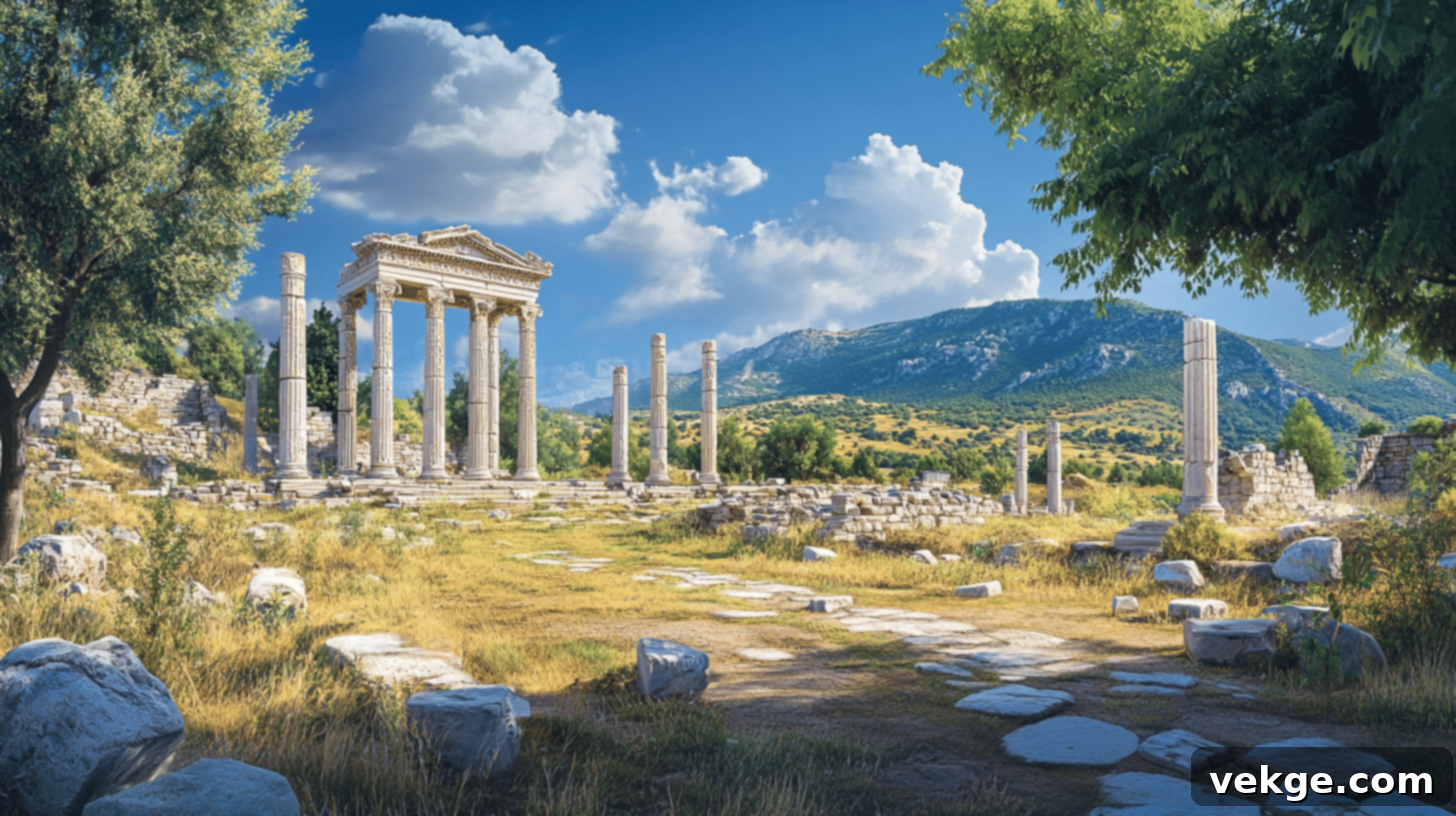
Once considered one of the Seven Wonders of the Ancient World, the Temple of Artemis at Ephesus was a colossal and awe-inspiring sanctuary dedicated to the Greek goddess of the hunt, wilderness, and childbirth. While tragically, only a few remnants remain today – primarily its foundations and a single reconstructed column – its historical significance is immense. In its prime, it was larger than any other Greek temple and famously adorned with precious metals and sculptures. Visiting the site allows one to reflect on the grandeur that once was and the sheer scale of ancient architectural ambition.
- Best Time to Visit: Similar to Ephesus (April-May and October) for mild weather.
- Guided Tours: While many standard Ephesus tours might bypass this site due to its limited remains, specific “Seven Wonders” themed tours often provide excellent historical context and bring its former glory to life.
- Entry Fees and Hours: Entry is free and accessible throughout the day, as it is not a regulated site.
28. Cappadocia’s Fairy Chimneys – Nevşehir
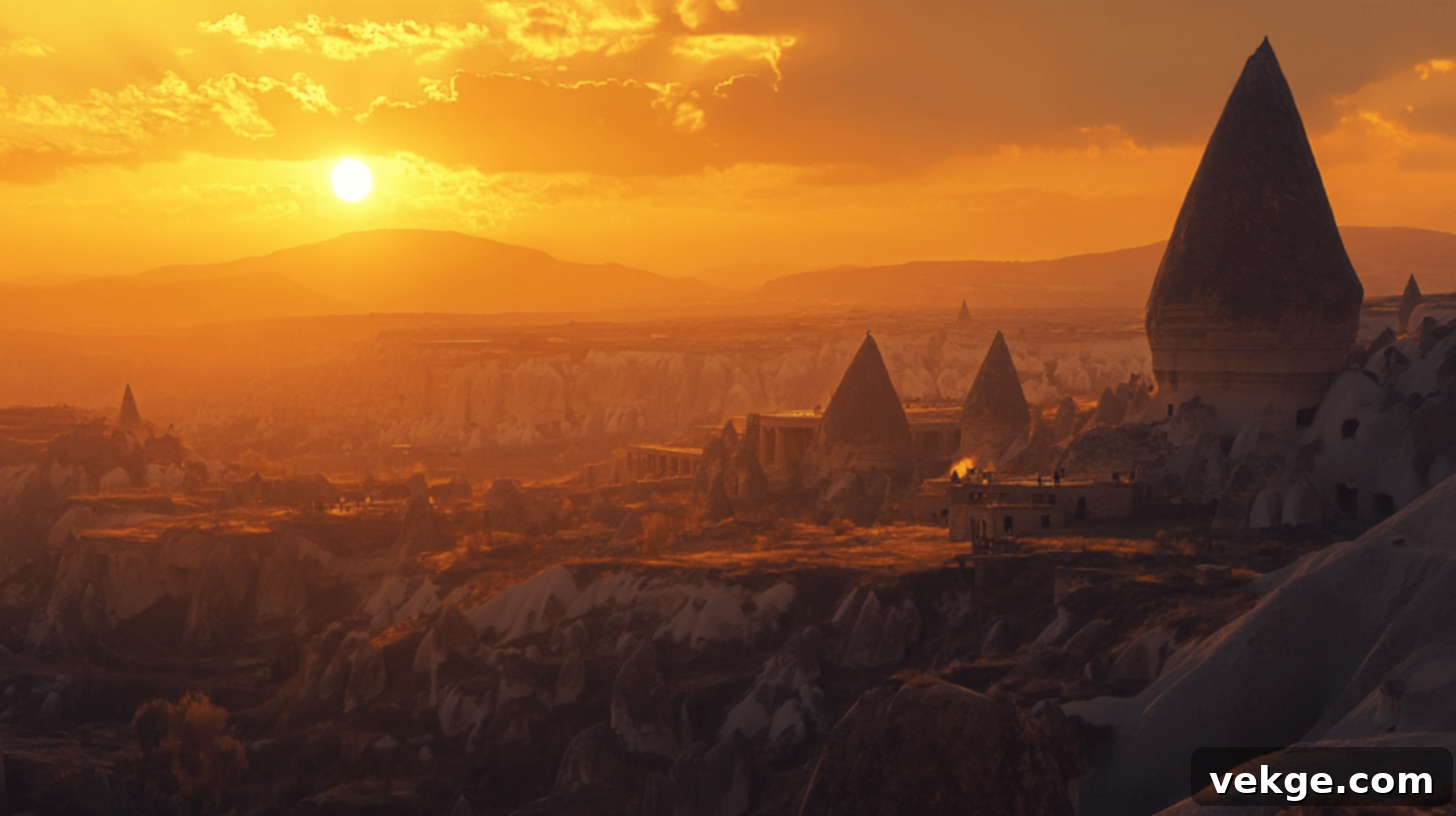
Beyond the general mention of Cappadocia, its “Fairy Chimneys” deserve special recognition. These truly unusual and iconic rock formations, sculpted by millennia of volcanic ash erosion, are the defining feature of the region’s landscape. Characterized by their distinctive cone shapes often topped with a harder rock “cap,” they appear almost whimsical, as if designed as tiny homes for magical beings. These geological wonders create valleys of unparalleled beauty and are best experienced up close through hiking or from above during a hot air balloon ride, offering endless photographic opportunities.
- Best Time to Visit: Coincides with the general best times for Cappadocia (April-June and September-October).
- Guided Tours: Hiking tours allow for intimate exploration of these formations. The Green Tour is particularly noted for including some of the most impressive fairy chimney sites.
- Entry Fees and Hours: Access to many areas is free, while some specific valleys or open-air museums may charge 50-100 TL. Generally accessible from dawn to dusk.
29. Chora Church (Kariye Museum) – Istanbul
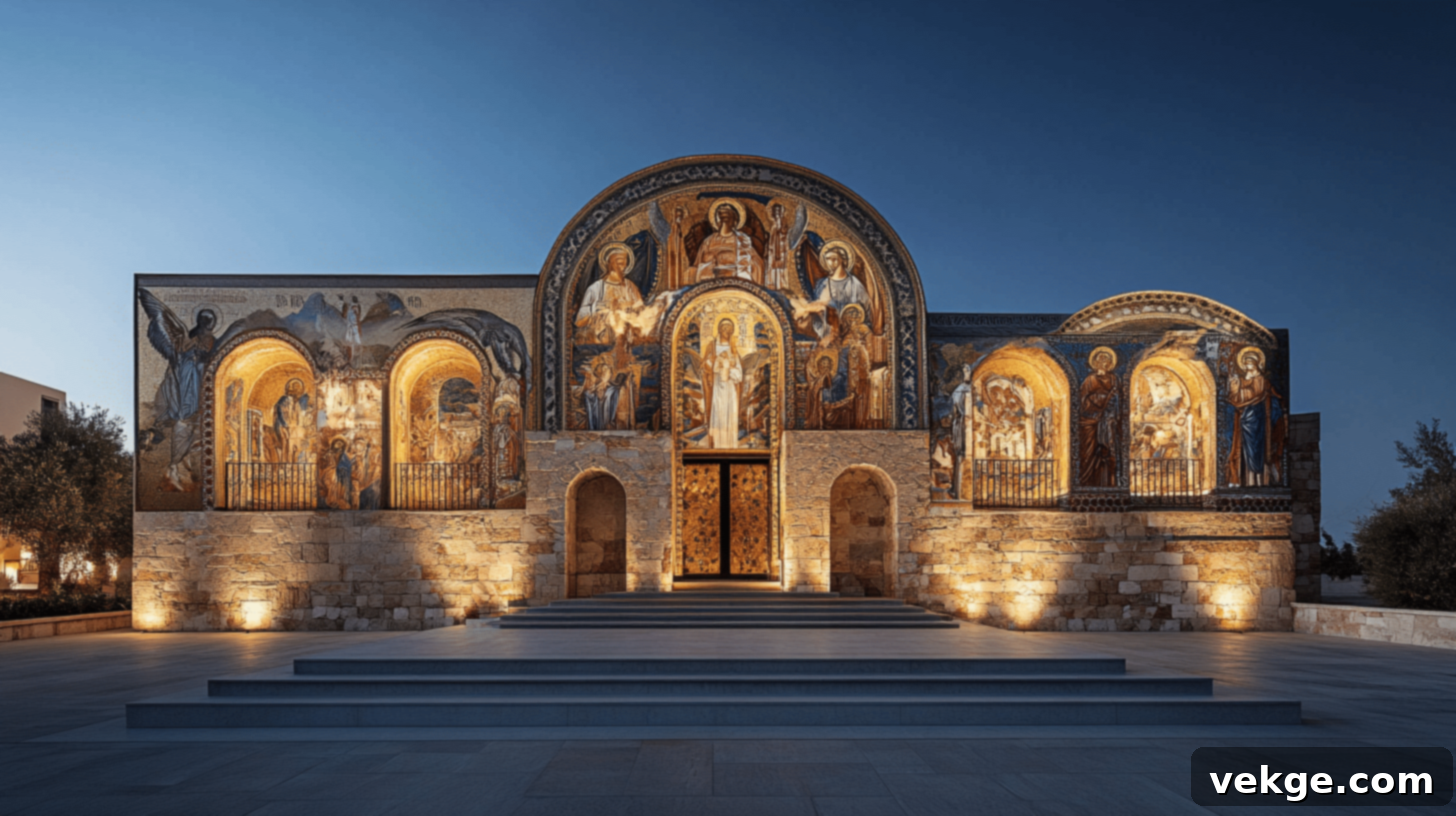
The Chora Church, now known as the Kariye Museum, is a jewel of Byzantine art and architecture, renowned for possessing some of the world’s most exquisite 14th-century mosaics and frescoes. These vibrant and remarkably well-preserved artworks narrate biblical stories with an unparalleled richness of detail and emotional depth, showcasing the pinnacle of Byzantine artistic expression just before the Ottoman conquest. Each panel is a masterpiece, offering a profound spiritual and artistic experience and reflecting the deep theological understanding of its creators.
- Best Time to Visit: Any time of year, as its interior lighting remains consistent, ensuring the frescoes and mosaics are always beautifully displayed.
- Guided Tours: Art history tours are invaluable for understanding the complex religious imagery, narrative sequences, and sophisticated artistic techniques employed in these stunning works.
- Entry Fees and Hours: Approximately €20 for foreign visitors. Typically open from 9 am to 6 pm.
30. Galata Tower – Istanbul
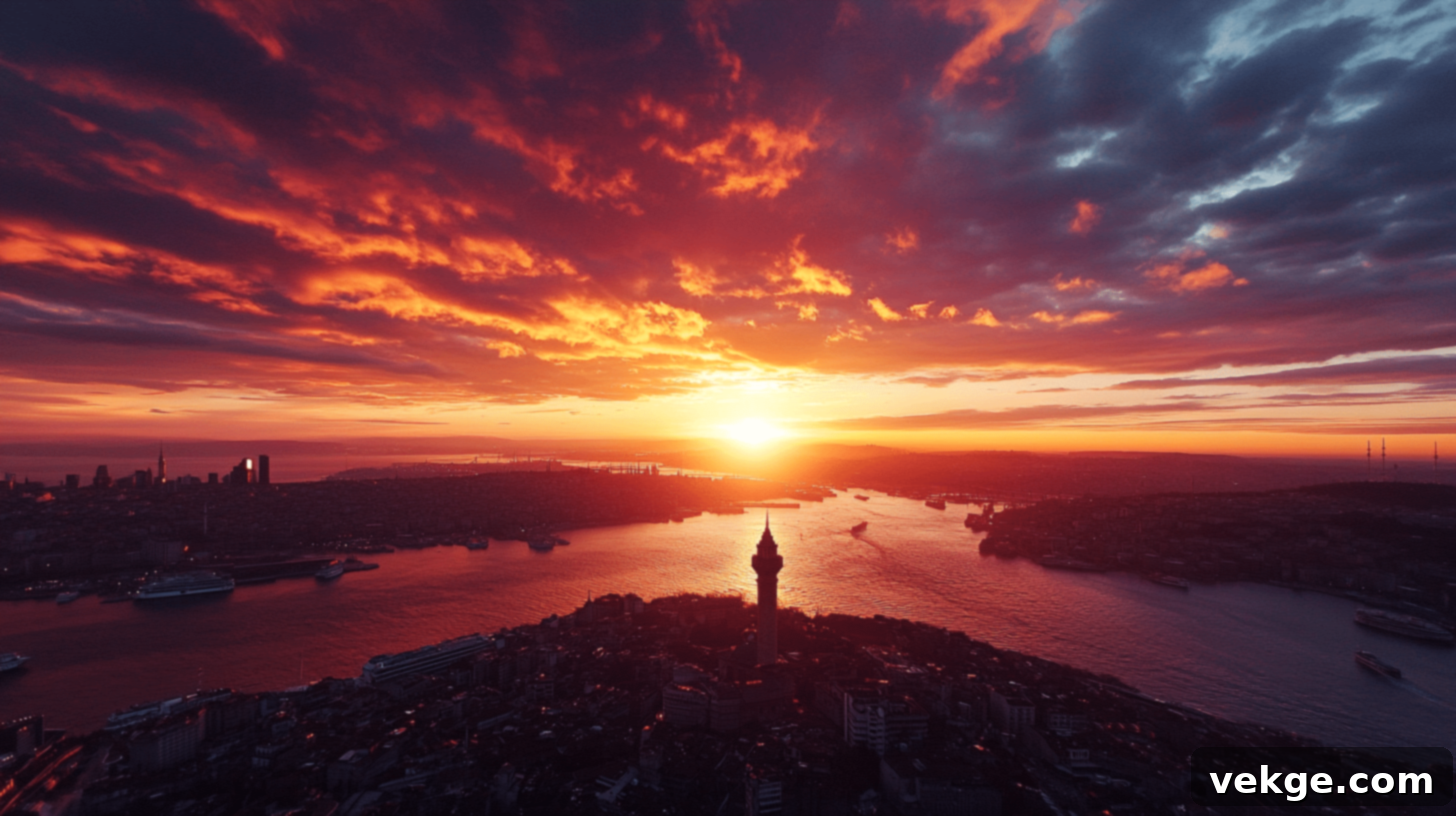
Standing proudly above the Galata district, the Galata Tower is a distinctive landmark with a rich history. Originally built in 1348 by Genoese colonists as a watchtower, this cylindrical stone tower, at 67 meters (220 feet) tall, was Istanbul’s tallest structure for centuries. It served various purposes, from a fire spotting tower to an astronomy observatory. Today, it offers visitors unparalleled panoramic views of historic Istanbul, the shimmering Golden Horn, and the majestic Bosphorus, providing an incredible perspective of the city’s vastness and beauty.
- Best Time to Visit: Weekday mornings are best to avoid the longest queues. April-May and September-October offer clear visibility and comfortable temperatures without the intense summer heat.
- Guided Tours: While there are no official tower-specific tours, many Istanbul walking tours, particularly those focusing on Genoese history or the Beyoğlu district, include a visit or a detailed explanation of the tower.
- Entry Fees and Hours: Approximately 400 TL for foreign visitors. Open daily from 8:30 am-11 pm, with the last entry at 10:30 pm.
31. Bergama Acropolis – Izmir
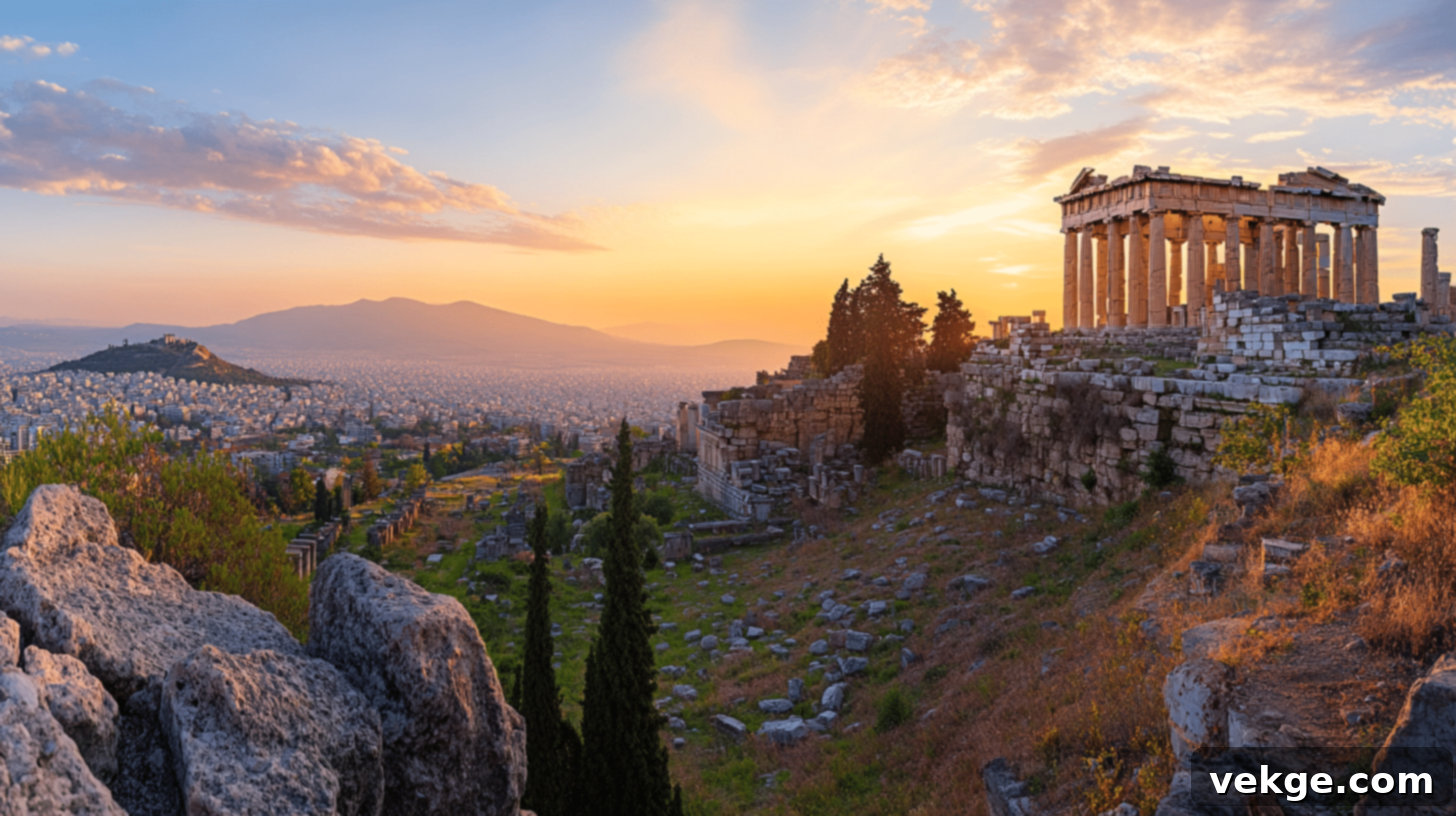
The Bergama Acropolis, another magnificent ancient Greek hilltop city, once rivaled Athens in its cultural and intellectual prowess. Its most striking feature is the dramatic theater, carved into a dizzying 38-degree slope, offering incredible views and an awe-inspiring sense of scale. The Acropolis also housed a significant library and the majestic Temple of Trajan. Pergamum (Bergama) was not only the birthplace of parchment but also a major medical center with the famous Asklepion. This site vividly demonstrates Hellenistic culture at its apex, with its blend of religious, intellectual, and architectural sophistication.
- Best Time to Visit: April-May and September-October provide mild weather. Morning visits are recommended for better light and cooler temperatures on the exposed hilltop.
- Guided Tours: Knowledgeable site guides are often available at the entrance. Combined tours with the Asklepion (the ancient hospital) and the Red Basilica offer a richer historical context.
- Entry Fees and Hours: Entry is approximately 200 TL. The cable car ride to the Acropolis is 60 TL each way. Open 8:30 am-7 pm in summer, and 8:30 am-5 pm in winter.
Summary: Unveiling Turkey’s Timeless Treasures
Turkey’s magnificent landmarks weave a compelling narrative, telling the story of the countless civilizations that have called this historical crossroads home for millennia. From the grandeur of imperial cities to the serene beauty of natural wonders, each site offers a unique window into different periods – be it the formidable Hittites, the classical Romans, the spiritual Byzantines, or the opulent Ottomans – all of whom left an indelible mark on this fascinating land.
With careful planning and utilizing the practical details we’ve provided, you can experience these incredible treasures with ease and depth. The ideal times to visit most of these historical and natural sites are during the pleasant shoulder seasons of spring and fall, when the weather is mild, and the crowds are noticeably smaller, allowing for a more immersive and comfortable exploration.
We sincerely hope this comprehensive guide inspires you to explore Turkey’s incredible heritage and helps you craft a journey filled with lasting memories and profound discoveries. For more insightful blogs and travel guides, we invite you to visit our website and continue your adventure planning!
Frequently Asked Questions About Turkey’s Landmarks
What is the most famous landmark in Turkey?
While Turkey is home to an abundance of world-renowned landmarks, Istanbul, as its cultural capital, hosts several of the most famous. Among them, the Hagia Sophia stands out as arguably the most iconic. Its unique history as a cathedral, mosque, museum, and again a mosque, combined with its breathtaking architecture and blend of Christian and Islamic artistry, makes it a universally recognized symbol of Turkey’s rich heritage. Other exceptionally famous landmarks include the Blue Mosque (Sultanahmet Mosque), Topkapi Palace, and the ancient city of Ephesus.
What is Turkey most famous for?
Turkey is celebrated globally for its extraordinary blend of cultural heritage, breathtaking historical sites, and stunning natural wonders. It is particularly famous for:
- Rich History: Home to ancient civilizations like the Hittites, Greeks, Romans, Byzantines, and Ottomans, leaving behind sites such as Troy, Ephesus, and the historical peninsula of Istanbul.
- Iconic Landmarks: World-renowned structures like Hagia Sophia, the Blue Mosque, Topkapi Palace, and the underground cities and fairy chimneys of Cappadocia.
- Natural Beauty: Unique landscapes like the white travertines of Pamukkale, the stunning Blue Lagoon of Oludeniz, and the lunar landscapes of Cappadocia.
- Delicious Cuisine: Famous for its diverse and flavorful culinary traditions, including kebabs, baklava, Turkish delight, and traditional breakfasts.
- Warm Hospitality: Turkish people are known for their welcoming nature and generosity towards visitors.
- Bazaars and Handicrafts: Vibrant markets like the Grand Bazaar and Spice Bazaar offer a treasure trove of traditional crafts, carpets, jewelry, and spices.
How many UNESCO World Heritage Sites does Turkey have?
Turkey is home to an impressive 19 UNESCO World Heritage Sites. These sites are recognized for their outstanding universal value, encompassing a diverse range of cultural and natural treasures, including ancient cities, natural landscapes, and historical monuments. Some prominent examples include the Historic Areas of Istanbul, Göreme National Park and the Rock Sites of Cappadocia, Hierapolis-Pamukkale, the Ancient City of Ephesus, Troy, and Mount Nemrut, among others.
Is Turkey good for historical tourism?
Absolutely, Turkey is an exceptional destination for historical tourism, arguably one of the best in the world. Its unique geographical position bridging East and West has made it a crucible of civilizations for thousands of years. Visitors can explore:
- Ancient Greek and Roman Cities: Ephesus, Pergamum, Aphrodisias, Aspendos, Myra.
- Byzantine Empire Remnants: Hagia Sophia, Chora Church, Basilica Cistern in Istanbul.
- Ottoman Imperial Grandeur: Topkapi Palace, Blue Mosque, Süleymaniye Mosque, Grand Bazaar in Istanbul, Safranbolu.
- Hittite Civilization: Hattusha, the ancient capital.
- Biblical and Mythological Sites: Troy, Mount Ararat, Seven Churches of Asia Minor.
- Early Christian History: Cappadocia’s cave churches, St. Nicholas Church in Demre.
Each region of Turkey offers distinct historical layers, ensuring a fascinating journey for any history enthusiast.
